SCOTTISH TRANSPORT AWARDS BOOK OF WINNERS
transporttimes

transporttimes




















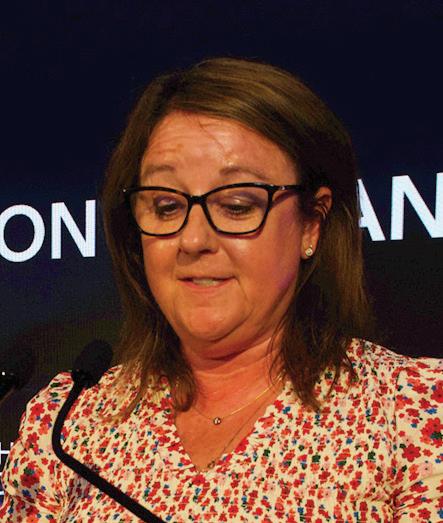
Alison Irvine Interim Chief Executive of Transport
Scotland and Chair of the Scotish Transport Awards Judging Panel
"Our children. Our grandchildren. They are relying on us to deliver a new sustainable transport system that is afordable, atractive and reliable"
It’s hard to believe that this is my second Scotish Transport Awards as Interim Chief Executive of Transport Scotland.
What a 12 months it has been.
As head of the Judging Panel I am in the extremely fortunate position of being able to see the vast array of inspiring achievements and success stories across our sector. Even that is just a snapshot and barely scratches the surface.
As usual, it’s been a very rewarding but tough process, because they all deserve recognition. Once again we’ve been in awe at the innovation and partnership in evidence across all of the categories.
We’ve seen so many fantastic examples of collaboration, creativity, overcoming adversity, and delivering solutions to complex problems. I know we sometimes take transport for granted, and perhaps only complain when things don’t to plan. Events like this one provide a welcome opportunity to change that and recognise delivery and impressive achievements across the sector.
Since returning to Transport Scotland, I’ve had the privilege of geting out and about and seeing many of these projects and meeting some of you in person.
I recently atended the formal opening of the new Levenmouth Rail Line (May 29th), which I hope will showcase the Fife Tourism Trail and breathe new life into the local economy. I was also able to visit the A83 Rest and Be Thankful and hear from those working on the
new phase. I’ve visited projects across the country. There are far too many projects and initiative to list one by one.
We’re also working alongside a relatively new First Minister, albeit one who is no stranger to transport. He absolutely recognises and appreciates the value and importance of a good transport system. One of his first visits since being formally appointed was to Levenmouth where he heard about the impact of the new rail line will have on local communities. He then returned to formally open the new line at the end of May.
As for the Cabinet, it’s inspiring to see strong and deserved female leadership at the heart of decision making, shaping the future of our country. Of course there is so much more to be done to address poverty, inequality, and improve diversity in our sector. I would like to see these principles embedded in our sector and become the new norm, not the exception.
I genuinely believe, and I know the Transport Secretary and First Minister believe, that transport can be a force for good. It can power the economy, rebuild communities, reconnect cities, tackle climate change, improve the health and wellbeing of our people – the priorities of our National Transport Strategy. What a responsibility, but what an opportunity. And everyone present at the Scotish Transport Awards on June 20th, and beyond, has a key role to play in terms of keeping up
momentum and delivering this lasting change for the beter.
Our children. Our grandchildren. They are relying on us to deliver a new sustainable transport system that is afordable, atractive and reliable. So, how do we do achieve this ambitious vision and make it reality? Well, we are soon going to find out. I believe we are on the cusp of a transformative phase.
Transport Scotland and the Scotish Government cannot however deliver these changes in isolation, but of course we must set the tone. Our eforts to reduce car use by 20% by 2030 is a good example. The tremendous success of free bus travel for under 22s. More 20mph zones, improved road safety and Low Emission Zones in our four largest cities. We can, and must, deliver a significant shift in terms of spaces where people can walk, wheel and cycle safely and confidently, puting people first, not cars and deliver a higher proportion of zero-emission vehicles on our roads and electrify our railways.
Of course, if we can’t convince the public of the merits of this approach, then it won’t happen and not much will change. So let us come together, share ideas, and speak with one collective voice on this ambition. We have a unique window of opportunity. We can deliver lasting change. Isn’t that why so many of us got into this field in the first place? Let’s not waste our moment.

Sponsored by Supported by

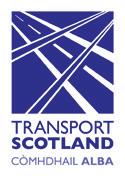








During the delivery of our works across Scotland’s Railway, where we come into contact with thousands of passengers and lineside neighbours each year, we also invest our time in engaging with communities.
In collaboration with our contractor partners, great eforts are made to connect with and support communities to bring about lasting social benefts.
As part of our Access for All (AFA) programme, where improved access helps make our stations more inclusive spaces, during our works at Port Glasgow station we created an informed group. This involved regular contact with the community council as representatives of the wider Port Glasgow community, who had tirelessly championed accessibility improvements in their area.

During the delivery of our AFA works at Uddingston station, we worked with Uddingston Grammar’s vision support team to meet with pupils to enable them to feedback on our project and share their experiences on the changes made to their station.
Over the last year, our maintenance delivery units in Glasgow, Motherwell, Edinburgh and Perth have forged strong community partnerships by supporting primary schools in areas facing signifcant socio-economic challenges.
Through volunteering our time and expertise, we are helping support communities with practical skills and assistance through these partnerships, such as working with primary

schools to improve pupils’ cycling safety skills and donating reconditioned bikes.
The construction of outside learning spaces and enhancing playground environments by installing colourful murals that involve the children’s creative input are other examples of where community partnerships are making a diference.
The response has been really positive towards our community partnerships which have engaged with over 1,300 pupils and have also opened up possibilities through STEM events to showcase to students the numerous paths that can lead into a career in the rail industry.
Over the last three years during delivery of the Levenmouth Rail Link in Fife, a huge project that reconnects communities to the railway for the frst time in over 50, this work is transformative as it has the potential to unlock access to education, culture, entertainment and employment opportunities.
From the outset, we sought to build on the sense of ownership and pride the community fostered towards the return of the railway by engaging extensively in volunteering days, safety talks, community initiatives and STEM events that reached over 5,600 school children and 40 local businesses.
The successful outcome of the Levenmouth Rail Skills Academy as part of the project saw all nine young local people who took part successfully secure employment once their training completed.
Scotland’s Railway is so much more than the transportation of people and goods – it is a journey that can generate lasting benefts for the communities it serves long after our work is complete.





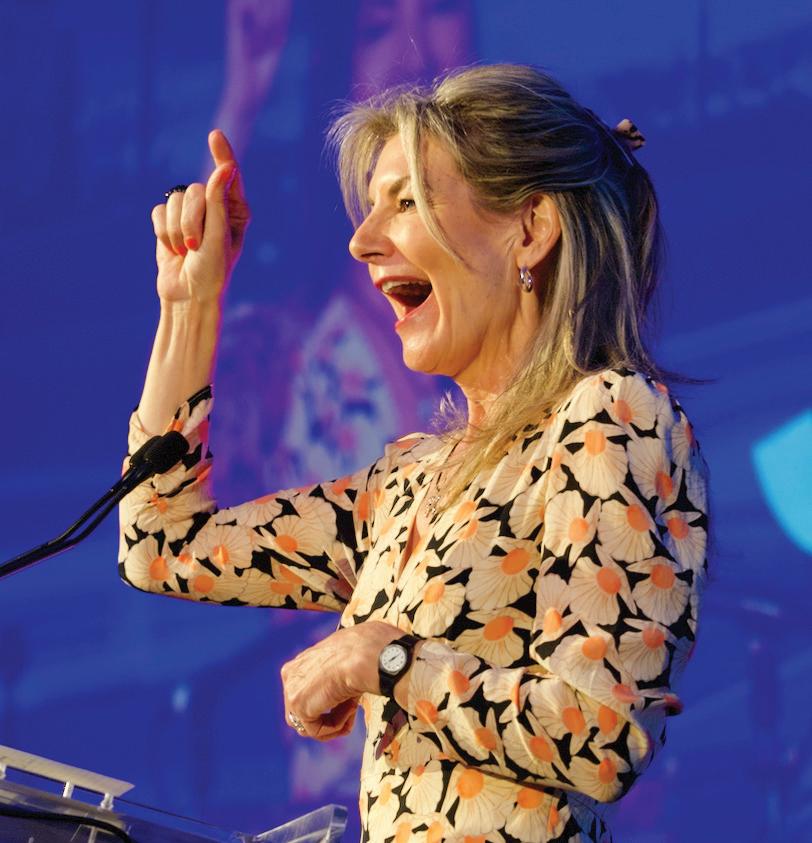
Scottish Transport Awards 2024 Sponsor

Delivering excellence for Scotland’s Railway




We are proud to have delivered civil engineering solutions throughout our CP6 Network Rail framework and look forward to continuing this support into CP7.

179 projects delivered


1.2million working hours

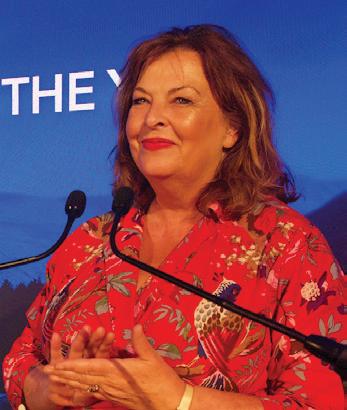
Fiona Hyslop Cabinet Secretary for Transport
"I firmly believe that transport can be a force for good. We are seeing significant spending on of public transport, with exciting initiatives like free bus travel for under 22s and older people, and cheaper peak rail travel"
What a tremendous honour it was to atend my second Scotish Transport Awards event on June 20th.
It provided a welcome opportunity to celebrate the many achievements and successes across planning, design, technology and innovation, road safety, active travel projects, delivering services – and many, many more. I was delighted to be able to present an award to the frontline employee of the year, and also to recognise the partnership working across all modes as we strive to address tough climate change targets and make transport more afordable, accessible and available for all users.
It’s encouraging that we continue to see a significant increase in journeys on public transport, an increase of almost 300 million journeys between 2021 and 2022. We’re not quite at pre-pandemic levels, but we are certainly on the right track. Around three-quarters of those were by bus. Which is why we continue to commit to actions that support the bus sector to play its vital role in delivering for people across Scotland.
I also took the opportunity to express my gratitude to staf across all modes who helped keep Scotland moving during such a turbulent winter period, with no fewer than 11 named storms to contend with, at times it felt relentless. It was thanks to the resilience and preparedness of our operators, transport workers and information providers that we were able to overcome these challenges.
I firmly believe that transport can be a force for good. We are seeing significant spending on of public transport, with exciting initiatives like free bus travel for under 22s and older people, and cheaper peak rail travel. We have saved and are saving
families thousands of pounds while we strive to make public transport more afordable, available and accessible. We know that poverty levels for many children, pensioners and families remain far too high. While we are doing our bit on transport, through free bus travel and concessionary fares to make buses a safer, more appealing option, and huge investments in rail and subway, we can always do more.
We also appreciate there is still a fallout from the global pandemic, and free, accessible travel is a great incentive for geting people of all ages out and about, as well as those accessing healthcare and essential services, across the country. We have some of the best heritage, cities, breathtaking scenery and countryside in the world – and we are a modern, ambitious nation too. We need to ensure our transport system supports our tourism sector and the wider economy, and underpins a healthier nation, which could save the NHS millions of pounds.
Through our investment of £300m every year, Scotland has the most generous concessionary fare scheme in the UK. The Child Poverty Action Group says free bus travel can save a total of £3,000 in the lifetime cost of a child in Scotland.
As we celebrate 25 years of the Scotish Parliament, it is fiting to stop and reflect and what’s been achieved. It has allowed us to transform transport policy and delivery in Scotland. For example, through the first ever Transport (Scotland) Act in 2001, we were able to create a framework for regional transport partnerships and a mobility and access commitee for Scotland, puting the needs of disabled travellers at the forefront of policy development. And
through the more recent Act, we now have some of the most transformational bus powers which will empower local authorities to take the lead once again on local bus provision. While there is clearly a role for national government in strategic transport decision making, enabling people to get around is also a local responsibility. A key aim moving forward is influencing how people travel. Public transport in many areas is already atractive, afordable and accessible – but it is patchy, and the cost of living crisis has clearly made it more challenging to maintain bus services. Our approach to free bus travel, is absolutely pivotal. I think of students who can make it to college, elderly people who can atend for medical appointments, and the hundreds of thousands of people who commute to their jobs, every single day. Enabling everyone to travel by train at any time at non peak fare levels is also key to encouraging more people to get around by train. I am pleased that one of the first things John Swinney announced on becoming First Minister was to extend this pilot.
I want to send a heartfelt thank you to everyone who is involved in Scotland’s transport industry. Looking ahead, we need to maintain focus and keep up momentum, and continue to improve bus, rail and ferry services. Everyone should feel safe to use public transport, so we’ve established a hate crime charter to make it clear that everyone, across modes of transport, has the right to travel without fear and harassment. If the last 25 years has provided a sample of what we can do, and if we can get all the powers and levers we need, to create the transport infrastructure our nation deserves, then can be very optimistic about the next 25.
Proud sponsors of the 2024 Scottish Transport Awards




QTS is a proud pillar of Scotland’s Railway
We have carried out essential works across the rail infrastructure throughout CP6.
We look forward to working with our framework partners throughout CP7 to help keep Scotland’s Railway moving.


1.6Million Hours worked
133 Schemes delivered
220,000m2 Mesh installed

Alison Irvine
Chair of the Judging Panel & Interim Chief Executive, Transport Scotland

Alison has held various policy and delivery posts across the Scotish Government, laterly leading the Cabinet, Parliament, and Governance Division, which covers all legislation and parliament business, the running of the Cabinet, and Protocol and Honours.
A Chartered Civil Engineer and graduate of the University of Strathclyde, Alison joined Transport Scotland in 2008. As the former Director of Transport Strategy and Analysis, she played a key role in developing the new National Transport Strategy, addressing transport aspects of the Climate Change Plan, and seting investment priorities through the Strategic Transport Projects Review. Alison supported ministers during Covid-19 and EU Exit, overseeing business case development and post-opening evaluations for major projects.
Before her time at Transport Scotland, she spent 18 years as a transport planner.
Alison is a graduate of the University of Strathclyde and a Chartered Civil Engineer.
Professor Iain Docherty
Dean, Institute for Advanced Studies, University of Stirling

In addition to his research and teaching, Iain has worked with and advised a range of private sector, governmental, and other organisations, including governments and public agencies in the UK, US, Australia, Canada, the Netherlands, Sweden, and the OECD.
In 2015, he was appointed by the ESRC and Innovate UK as one of five Thought Leaders working to integrate scientific innovation and social science research across the UK, and subsequently as one of the Co-Investigators and Infrastructure Theme Lead of the £1.2m ESRC Productivity Insights Network bringing together leading social science academics to help address the UK economy's resilient productivity gap. In 2021, he was appointed as a Director of the National Transport Authority in Ireland.
Dr George Hazel OBE Director, George Hazel Consultancy

George is a Director of the George Hazel Consultancy, an Adjunct Professor at Queensland University of Technology and Chair of the Advisory Panel for the Transport Research Institute, Edinburgh Napier University.
He was a member of the UK Secretary of State for Transport’s Steering Group for National Road User Charging, Chair of the World Roads Congress C10 Commitee, researching urban areas and transport, Chair of the Scotish Public Policy Unit’s Transport Commission and Chair of Transport 2000’s Forum on Revitalising Communities on Main Roads. He is an expert on towns and city regions and has writen a book on Making Cities Work.
Previously, he was Professor of Transport Policy at the Centre for Transport Policy, where he looked after the consultancy business. From 1996 to 1999, he was Director of City Development for the City of Edinburgh Council, responsible for planning, economic development, transport and property.
Daisy Narayanan MBE
Public Realm Director, The Crown Estate

Daisy Narayanan is the Head of Placemaking and Mobility at the City of Edinburgh Council, where she leads the delivery of a city-wide integrated approach to transport and placemaking.
Daisy is on the Board of Architecture & Design Scotland and a member of the Evidence Group for Scotland's Climate Assembly. She was on the Active Travel Task Force set up by the Minister for Transport and the Islands. She recently won the Civic Servant of the Year Award from the Academy of Urbanism.
Drawing on her previous experience as an architect and urban designer in India, Singapore, England, and Scotland, Daisy is passionate about creating places for people - places that reflect and complement the communities that live in them.
Betina Sizeland Director of Bus, Accessibility and Active Travel, Transport Scotland

Betina recently joined Transport Scotland as Director for Bus, Accessibility and Active Travel (BAAT). A chartered civil engineer, she previously worked for the Scotish Government as Deputy Director for Culture and Historic Environment and, before that, as Deputy Director for Tourism and Major Events. She previously spent 10 years in Africa and Asia as an engineering adviser for the Department for International Development.
As Director for BAAT, Betina oversees the delivery of an ambitious policy agenda, working with delivery partners to improve sustainable, accessible transport options and get the travelling public back to buses, walking, cycling and wheeling. Her Directorate also operates concessionary travel schemes and works with operators to ensure all journeys on Scotland's bus, rail, ferry, subway and tram networks can be ticketed or paid for using smart technologies.
Robert Jack
Managing Editor and Publisher, Passenger Transport

Robert Jack has been a transport journalist for 25 years. After studying Geography he spent a year working for a company that imported buses and coaches before moving to London to take on a role as an Editorial Assistant at Transit magazine. Within two years, he became the magazine’s Editor, covering developments in the UK public transport sector.
In 2011 he left Transit and co-founded Passenger Transport magazine, a new title for the public transport sector which provides a first-class source of news, analysis and comment. He is the magazine’s Managing Editor and is based in Edinburgh.
In 2019, Robert was named Journalist of the Year at the National Transport Awards in London.


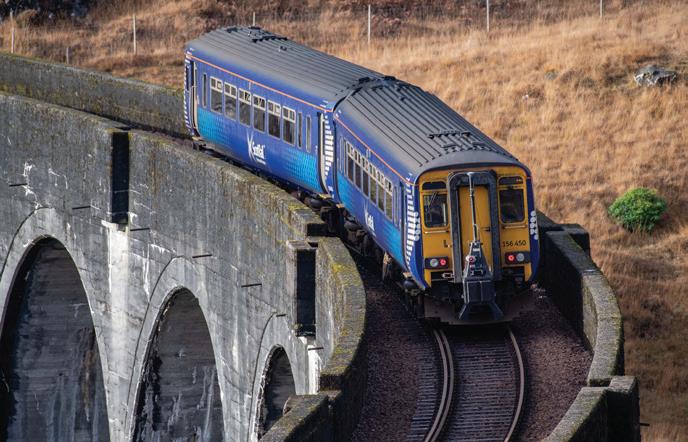





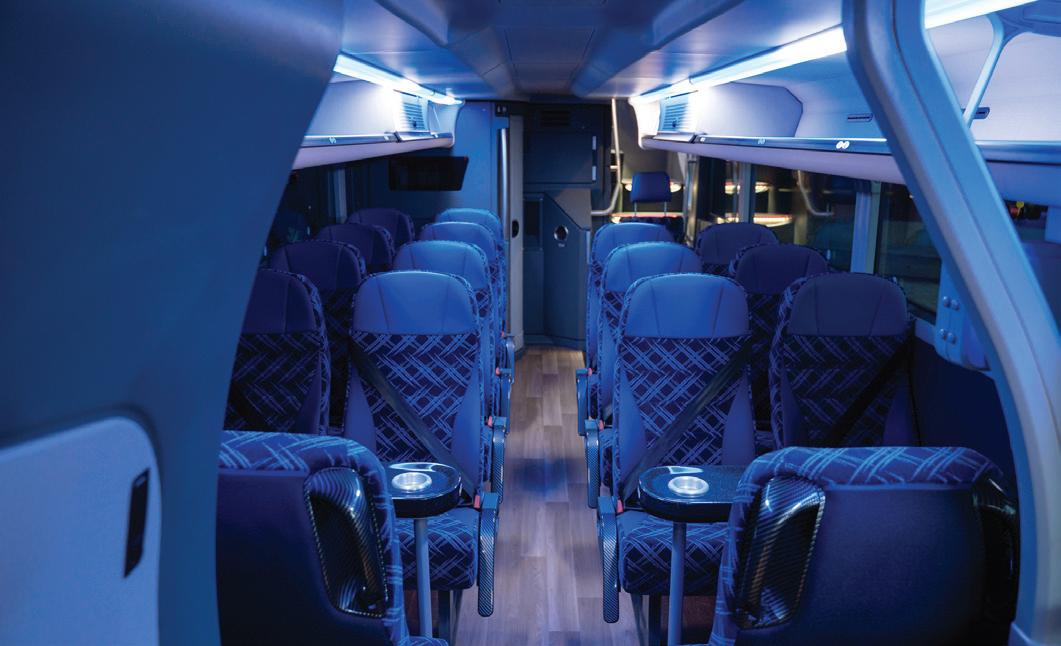





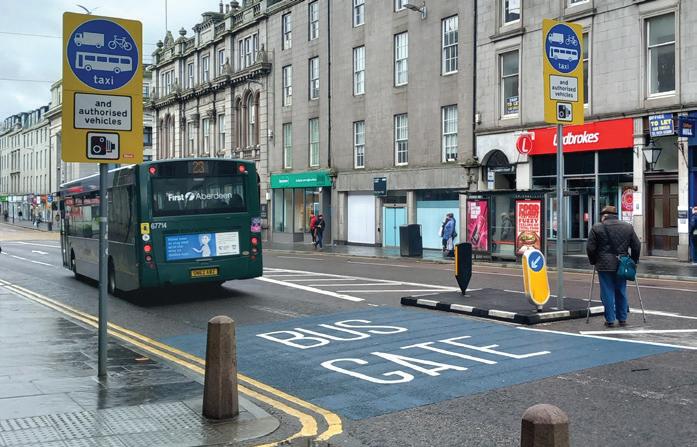


A submission in this category should demonstrate how changes to bus services and facilities have improved them. An increase in passenger numbers, modal shift, improved customer satisfaction ratings, or improved reliability are all examples of ways success could be documented.
The 55 Bus
Glenfarg Community Transport Group (GCTG) is a Scotish Charity (SC052068) established by the Community Council to address public transport challenges. The group, managed by a board of six trustees and supported by five salaried drivers and fifteen volunteer drivers, operates The 55 Bus Service in a Public Social Partnership with Perth and Kinross Council. This service runs hourly, six days a week, 11 times daily in each direction. Initially operating between Glenfarg and Kinross, the route has been extended to Perth.
The 55 Glenfarg to Kinross service was the first phase, with the extension to Perth marking the second phase. The proposed third phase aims to serve West Kinross-shire, while the final stages will extend coverage to the rest of Kinross-shire and include evening and weekend services. The ultimate goal is to create a cohesive local bus service that connects with mainline services at Kinross Park and Ride, providing a viable alternative to car travel.
GCTG was initially set up to ofer traditional Community Transport activities, such as organising outings and providing buses for local groups to hire. This serves as a backup for the service bus, with a pool of buses and volunteer drivers available to ensure business continuity. Recognising that a traditional fixed-route bus service would face similar issues as past operators, GCTG consulted the community to understand their needs. The consultation revealed that many residents needed more transport to neighbouring towns, highlighting a significant unmet need.
In response, GCTG designed a flexible service combining fixed routes with deviations, or "wiggles," to serve previously unserved areas and assist those with mobility issues who struggle to reach bus stops. The service utilises sixteenseat minibuses operated under Section 22 licences. Initially, bookings were made via telephone, but the service has now introduced the MooveFlexi/Liftango App.
One of GCTG's primary goals is to establish a replicable and scalable model to provide solutions for other communities

facing similar public transport challenges. Each phase is piloted for the first few months to ensure that research translates into practical results. In phase one, GCTG aimed to double the number of passenger journeys from the previous service (120 journeys). This target was achieved in three months, reaching 250 journeys, and exceeded 400 journeys by the end of the year. Phase two has set an ambitious target to double this number to 800 by the end of the current pilot in June. After one month of operation, the service already reaches 750 passenger journeys per week.
Behind these numbers, GCTG recognises the service's social impact. The 55 bus helps combat loneliness and improve mental and physical health, generating social benefits that are challenging to quantify. To further explore these benefits, an MSc student from Oxford University will research to provide evidence.
The service has been promoted extensively through social and traditional media, fostering community engagement and ownership. Passenger satisfaction has been high, as evidenced by surveys and reviews, and the service has garnered national press coverage, including articles in The Courier and The Guardian and features on BBC Online, BBC Reporting Scotland, and BBC Morning Live.
GCTG continues to strive to reduce public transport challenges and achieve its targets with a vision of providing safer, more accessible, and sustainable transport
options for the community.
For more information, visit www. GlenfargCT.co.uk or follow the Facebook Page: Glenfarg Community Transport and the Facebook Group: Glenfarg Community Transport Updates.
Commended:
Stagecoach East Scotland: Fife to Edinburgh Airport on JET747
Other shortlisted entries:
Lothian Buses: Airlink - Service 100
McGill’s Bus Service Ltd: ClydeFlyer
McGill’s Bus Service Ltd: Unilink
ScotRail: Glasgow Station Bus Link
Scotish Citylink Coaches: Service 902: Glasgow to Edinburgh Airport via Monklands and Livingston
Stagecoach North Scotland: Stagecoach Aviemore Adventurer
Previous winners:
2023: Strathclyde Partnership for Transport: Keeping Communities Connected
2022: Scotish CityLink Coaches – Saltire Cross Network
2020: Scotish Citylink Coaches - Service 900: Glasgow – Edinburgh
2019: First Glasgow, Service 75 – Best Bus Service
2018: Stagecoach West Scotland, Go More With X74
Sponsored
by

This category encompasses all road safety, trafic management, and enforcement aspects. Projects that qualify are speed management, road space reallocation projects (for example, bus lanes), and parking enforcement schemes. We will look for results such as casualty reductions, improved journey reliability, modal shift, or congestion reduction.
South Lanarkshire Council Road Safety Programme
The region, home to over 319,000 residents, spans 180,000 hectares from near Glasgow's city centre to the boundary with Dumfries and Galloway, encompassing both rural and urban environments. The area demonstrates a solid commitment to road safety through its established Road Safety Forum, which collaborates with partner agencies to focus resources and actions on agreed priority areas as outlined in the Local Transport Strategy.
Proactively contributing to national casualty reduction, the region continually monitors and investigates collisions on its road network. An annual detailed analysis of collisions is conducted to set local priorities, aiming to provide the most significant benefit to the community. The region implements a holistic Road Safety Programme based on the 4 E’s of road safety: education, engineering, enforcement, and encouragement, alongside the Safe Systems Approach. This approach aims to prevent collisions that result in death and severe injury by focusing on Safe Roads, Safe Speeds, Safe Vehicles, and Safe People.
The education component adopts a 'whole life' approach, emphasising the development of good road safety habits from a young age. Engineering eforts include two significant annual initiatives. The Route Action Plan (RAP) programme addresses sections of rural Class A/B roads with accident rates above the national average by identifying and implementing measures based on common factors. Individual 'cluster site' locations with three or more injury collisions over three years are also identified and treated.
Enforcement activities involve liaising with Police Scotland and the Safety Camera Programme to prioritise surveillance and joint accident analysis. Under decriminalised parking, enforcement of parking restrictions
at road safety concern sites is also prioritised. Encouragement eforts use social media, publications, and campaigns to communicate various road safety messages and information, fostering compliance and support.
Integrating the 4 E’s of road safety and the Safe Systems Approach has led to successful casualty reductions. Higher speed and rural roads, which are the focus of council eforts, are understood to account for a more significant number of killed and seriously injured (KSI) collisions. Specifically, 59% of KSI collisions occurred on A and B class roads within the most recent three years, with a similar patern over 10 years.
The RAP programme aims to implement engineering measures based on common causation factors identified on such routes. Priority groups, as detailed in the Road Safety Framework, are identified in investigations resulting in KSI casualties. Weighting factors are added to KSI severities and targeted groups to prioritise interventions and directly contribute to national casualty reduction targets. Reports include site descriptions, accident analysis, treatment options, and economic assessments, including each identified site's First Year Rate of Return (FYRR). Cluster collision sites are also identified and treated accordingly.
Success is demonstrated by comparing the baseline (2014-18) to the most recent five-year average. Fatal casualties have been reduced by 11% and severe injuries by 39%, resulting in significant economic savings and lessening the devastating efects of injury
and loss of life. Additionally, the number of children killed or seriously injured has decreased by 75%. There has been an overall reduction in all severities by 51%, compared to a national decrease of 45%.
The Road Safety Programme will continue to drive collision reductions and achieve the 2030 targets, resulting in safer roads, speeds, vehicles, and people.
Other shortlisted entries:
Aberdeen City Council: Aberdeen City Centre Bus Priority Measures
Clearview Intelligence on behalf of Transport Scotland and Amey: A78 Pennyburn to Eglinton Speed Compliance Scheme
Glasgow City Council: STARS School Travel and Road Safety
Renfrewshire Council and SRL Trafic: SRL Urban64® | M8, Junction 25a (Braehead)
South Lanarkshire Council: South Lanarkshire Council Bus Priority Programme
Previous winners:
2023: Glasgow City Council: Ultra Smart Cycle System (USCS)
2022: South Lanarkshire Council – Casualty Reduction Programme
2020: City of Edinburgh Council - 20mph Programme
2019: Scotland TranServ, Strategic Road
Safety Team: Saving Lives through Innovation 2018: Police Scotland’s Operation Close Pass supported by Cycling Scotland and Road Safety Scotland
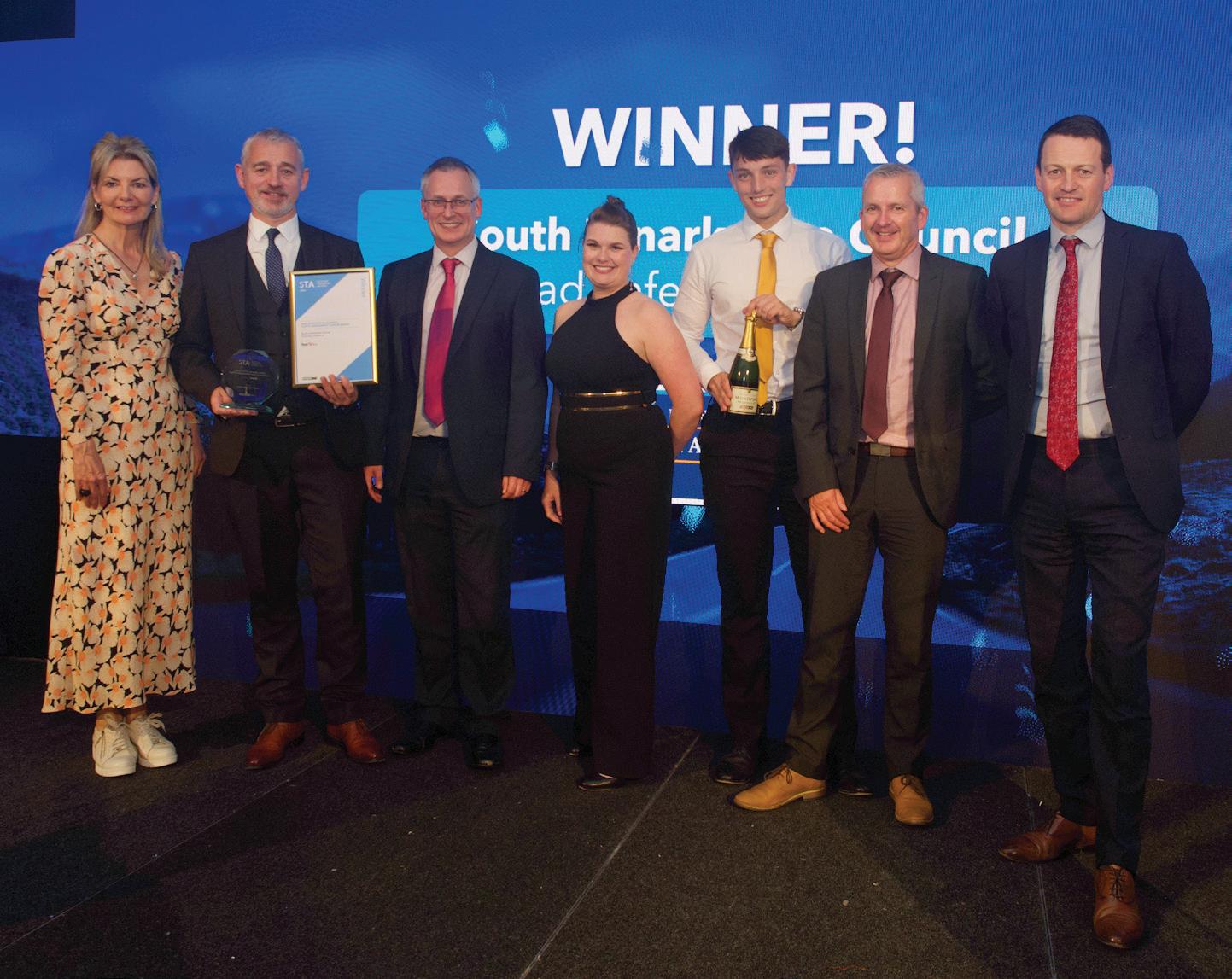










An entry in this category should demonstrate developments in school and work transport schemes, which have delivered modal shift or improved safety.
Active Travel Dundee at Ancrum Outdoor Centre oversees Bikeability Scotland cycle training in Dundee. Derek Napier, Outdoor Learning Manager, heads a team of coordinators, including Norbert Boros, Callum Riddoch, and Billy Thomson. The team works with volunteers, teaching staf, and all 33 primary schools in Dundee to help pupils benefit from cycle training and other active travel initiatives.
Cycling Scotland, the national cycling organisation, supported this nomination. Working with others, the charity helps ensure that anyone, anywhere, can cycle easily and safely. Cycling Scotland manages Bikeability Scotland cycle training with funding from Transport Scotland.
While Dundee Council has been engaged with the Bikeability Scotland programme since its inception in 2010, the first few years faced coordination challenges, which resulted in no on-road cycle training being delivered in the authority’s schools. However, in the subsequent decade, with the first coordination responsibility shifting to Ancrum Outdoor Centre, followed by annual grant funding support for a designated full-time coordinator post provided by Cycling Scotland, delivery has gone from strength to strength.
In the last academic session (2021-22), Dundee was only the sixth local authority in the country to deliver Bikeability Scotland training to all of their primary schools. All but one school ofered Level 2 on-road training, with a total of nearly 3,000 pupils having the opportunity to develop this essential skill for life. Level 2 teaches critical competencies such as efective signalling, making good observations and correct road positioning, and encouraging young people to make more short journeys by bike. The decision-making element is critical in enabling children to conduct safe on-road journeys, including, where practicable, travelling to school. This is particularly beneficial as pupils transition from primary to secondary, often facing longer journeys.
Working with Cycling Scotland, the Active Travel (Schools) team at Ancrum now provides a complete package of support for curricular-based cycle training to Dundee schools, including school engagement and road safety information, as well as access to instructors, bikes and bike maintenance.

This activity is further consolidated by a range of other services, which in the past year have included support for the development of school travel plans through the establishment of pupil-led active travel clubs, cycle path community liter picks, led bike rides to school trips, after school bike clubs, free bike provision, and essential cycle skills training for families. Dundee Council’s Bikeability Scotland programme has strengthened existing partnerships with and between local primary schools and helps ensure that promoting active travel to school is a collective responsibility.
From 2010 to 2016, the average annual delivery rate for Bikeability Scotland cycle training in Dundee was 12% of primary schools, much of which was playgroundbased. In 2021-22, and after two heavily disrupted years during the pandemic, Dundee delivered Bikeability Scotland training to all of their 33 primary schools for the first time, with nearly 3,000 pupils benefiting from the opportunity to develop essential life skills.
This included 97% of the authority’s primaries participating in Level 2 on-road training, with over 1,300 pupils involved. It compares favourably to the national figure of 50%, a record for the programme.
Dundee delivered all three levels of Bikeability Scotland training in 2021-22, with over 50 secondary pupils participating in Level 3. The Active Travel Dundee team delivered six Bikeability Scotland Instructor courses in 2021-22, training 32 volunteers and school staf to support delivery. Knowledge and skills acquired through Level 2 on-road training were consolidated on led rides, some of which helped facilitate local school
trips. Twelve rides took place, involving more than 300 pupils.
More than four-fifths (82%) of parents are more likely to let their children cycle after completing Bikeability Scotland training. Almost two-thirds (65%) of pupils were more confident cycling and 45% reported cycling more frequently.
Ben Clark, Principal Teacher at Eastern Primary School, said: “As well as ofering Bikeability sessions, the Ancrum team met regularly with our active travel group, listening to pupils’ voices and helping them promote active travel to school.”
Eva, a pupil at Eastern, added: “Thank you Bikeability for helping me gain my confidence back on my bike.”
Other shortlisted entries:
Aberdeenshire Council: Fraserburgh South Park School Trafic Management Zone
Cycling Scotland: Bikeability Scotland cycle training, managed by Cycling Scotland East Lothian Council and Stantec: North Berwick Safer Routes to School
Previous winners:
2023: Cycling Scotland: Active Travel Dundee (Schools) Bikeability Scotland cycle training supported by Cycling Scotland
2022: Living Streets - WOW Activity Tracker
2020: South Lanarkshire Council - School Travel Plans
2019: Western Isles Council Bikeability Scotland cycle training, supported by Cycling Scotland
2018: Sustrans Scotland - Scotish Workplace Journey Challenge
Entries in this category must demonstrate how particular policies and projects have improved the street environment. Examples of initiatives for this Award include environmental enhancement schemes, pedestrian schemes or parking and warden policies. Before and after photographs help the Judges with this category; alternatively, a cycling strategy may form the basis of a submission for this category or an individual scheme, which has brought significant benefits. Increased numbers of people cycling or reduced cycle casualties are two ways that you could document the success of your work.
Glasgow City Council (GCC) is enhancing community connectivity by developing new walking, wheeling, and cycling links while removing barriers to active travel. By working closely with communities to identify everyday active travel destinations, GCC is commited to inclusive and accessible design. The overarching vision is for active travel to become the preferred choice for everyday journeys. As a city, Glasgow is dedicated to providing and promoting a high-quality cycle network to reduce car dependency.
In June 2023, phases 6 and 7 of Glasgow’s East City Way (ECW) were completed, adding 2.5 km of with-flow segregated cycle infrastructure that seamlessly links Glasgow Green and the city centre with the east end of Glasgow. This project was developed with Trafic colleagues and major stakeholders, including Celtic FC. The ECW now ofers a fully segregated route connecting the city centre with cultural assets such as the Emirates Arena and Celtic Park. Beyond improved cycling facilities along London Road, the project enhances the pedestrian experience with resurfaced footways, removed pedestrian guardrails, and upgraded crossings.
Before to the ECW construction, road space was reallocated under the Spaces for People programme, which dedicated 50% of the carriageway to cyclists. This initiative provided the baseline for long stretches of uninterrupted hard segregation for the ECW, reducing vehicle speeds and making the route more appealing to both pedestrians and cyclists. The route includes five junctions, utilised by service vehicles from surrounding industrial units and significant numbers of visitors to sporting events at the Emirates Arena and Celtic Park. These junctions feature cycle-activated detectors, allowing for cycle-only phases,
ensuring safe passage through these oftenbusy intersections.
The Clyde Gateway junction, previously characterised by a multi-stage pedestrian phase with barriers and large crossing distances, has been upgraded to feature shortened pedestrian crossing points and times and a protected “cyclops” junction for cyclists. This junction is potentially the largest of its kind in the UK. An additional 800 m² of soft landscaping and greenery was introduced to enhance the public realm. Phases 6 and 7 were completed in time for the 2023 UCI World Cycling Championships, which saw the Emirates Arena host numerous events.
The ECW project has delivered 2.5 km of fully segregated cycle infrastructure, encouraging active travel and enhancing the viability of cycling for everyday journeys. In the first three months of operation (July 2023 to September 2023), the new cycling route saw 24,061 cycle journeys, representing a 318% increase compared to pre-construction cycle use. Cyclists can reach Celtic Park and the Emirates Arena from the city centre in 20 minutes, likely reducing car journeys to these popular atractions.
All signalised pedestrian crossing points along the route have been equipped with “Smart-Cross” technology. This system allows for touch-free activation of the pedestrian phase by waving a hand under the signal box. Also, it includes a SmartCross buton beneficial for wheelchair users, parents with prams, and cyclists.
GCC’s commitment to improving active
travel infrastructure is evident in the success of the ECW project. By providing a safer and more accessible route for cyclists and pedestrians, the initiative supports the city’s vision of reducing car dependency and promoting sustainable travel options.
Commended:
Cycling Scotland and NG Homes: Supporting social housing tenants to travel by bike
Other shortlisted entries:
Aberdeenshire Council: Caroline Wells Woods
City of Edinburgh Council: City Centre West to East Link and Street Improvements Project
Cycling Scotland: Access to Bikes for Young People
Dundee City and Angus Councils: Broughty Ferry Monifieth Active Travel
Glasgow City Council: Sighthill Footbridge HITRANS: HI-BIKE
ScotRail: Stirling Station project and "Walk Cycle Live Stirling"
Previous winners:
2023: Aberdeenshire Council: The Aberdeenshire Bothy
2022: Joint winners: Cyclehoop Ltd & Glasgow City Council
2020: City of Edinburgh Council, Edinburgh Cycle Hire Scheme
2019: Aberdeenshire Council, Integrated Travel Town Masterplan Project Approach

A submission in this category should demonstrate how your organisation has implemented policies to reduce its environmental impact (for example, reduced carbon footprint), supported by clear results. The types of projects that qualify for this category include using alternative vehicle fuels and technologies or freight practices that have resulted in mileage and/ or emissions/reductions.
The North East Bus Alliance, formed in 2018, comprises Aberdeen City Council, Aberdeenshire Council, Nestrans, First Aberdeen, Stagecoach Bluebird, and Bains Coaches. This coalition aims to enhance bus passenger experiences across the region and atract more passengers by developing and implementing a regional Bus Action Plan. The Alliance collaborates with Transport Scotland’s Bus Partnership Fund (BPF) team to deliver new bus priority measures.
In recent years, the north east region has experienced a decline in bus patronage. Historically, Aberdeen City Centre has been highly accessible by private car, exacerbating this decline and resulting in increasing trafic congestion. This congestion has resulted in prolonged and unatractive journey times for bus passengers and increased fares. The area around the bus station has been particularly afected, with buses facing lengthy delays in accessing and leaving the facility.
In 2021, the Bus Alliance received £12 million from the BPF to develop and implement bus priority measures in the region. The first BPF infrastructure project in Aberdeen was completed in Autumn 2023, including improvements to South College Street and a new city centre active travel and public transport priority loop, cofunded by Nestrans. These improvements, identified as a priority in the Aberdeen City Centre Masterplan (CCMP), enhance the operation of a key corridor to and from the city centre for all modes of transport and enable significant trafic restrictions within the central core.
The new measures include a network of active travel and public transport priority streets (Union Street, Market Street, Guild Street, and Bridge Street) to support safer walking, wheeling, and cycling and a more eficient passage of buses through the area, improving access to the bus station. Bus gate enforcement cameras are located at restriction points to reduce non-essential trafic in the afected area while maintaining legitimate residential and business access. These measures support safer and
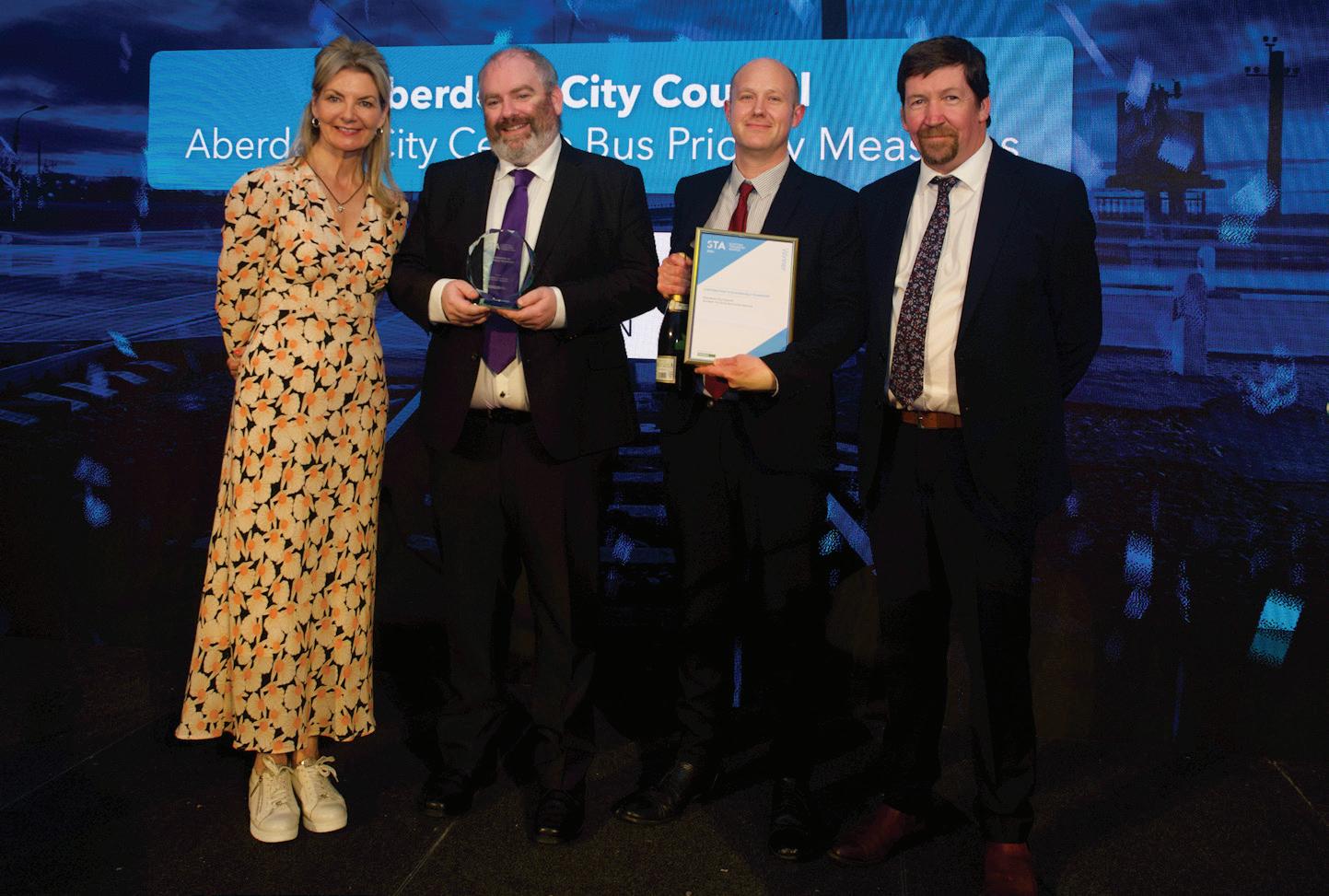
more eficient active travel and public transport movements and complement the forthcoming Low Emission Zone and broader CCMP objectives for developing a more welcoming and atractive city centre.
As a result of the new measures, 600,000 people per month are experiencing improved punctuality (over 95%) and faster journeys, with bus journey times in the city centre reduced by up to 25% (equating to a five-minute saving on a 20-minute trip), according to operator data. This improvement in journey times has increased confidence among passengers, as reflected in a recent survey showing 81% satisfaction with bus services and 86% satisfaction with journey times.
The enhancements have also led to a near 10% growth in bus usage since the measures were implemented. These changes were introduced via an Experimental Trafic Regulation Order, allowing for refinement based on feedback. Since their introduction, the Council has worked with bus operators to identify and implement supporting interventions, such as trafic signal adjustments, to improve performance further and maximise benefits for passengers.
In response to concerns about legibility, the BPF granted additional funding to make restrictions more visible to the public, with extra signs and road markings to ensure penalties are not issued unfairly. The Alliance has coordinated with the BPF team to publicise the benefits of the new measures, providing information and resources centrally on the Getabout website.
Both First Aberdeen and Stagecoach Bluebird have commited to reinvesting annualised savings from the new measures to benefit customers and encourage new passengers. As part of this commitment,
both operators will ofer free weekend travel across the region during January 2024. Working in partnership has been invaluable, with Bus Alliance partners collaborating closely with Transport Scotland to deliver new infrastructure, raise public awareness, and adapt measures in response to feedback to ensure maximum benefits for all.
Other shortlisted entries:
Aberdeen Airport: Introducing Electric Buses
Amey: Driving Change: Amey South-West Trunk Roads Accelerates Adoption of ULEVs City of Edinburgh Council: City Centre West to East Link and Street Improvements Project
Climate Action Strathaven: Climate Action Strathaven 3C Service Strathaven to Glasgow First Bus Scotland: First Bus Scotland
HITRANS: HI-BIKE
Stagecoach: Leading the Way in Sustainable Transport
Zenobe: McGill's and Zenobe bring more electric buses to Johnstone, Inchinnan and Greenock
Previous winners:
2023: WSP and Highland Spring Group: Blackford Rail Freight Facility
2022: First Glasgow - Electrification of the UK's biggest bus depot
2020: BOC - BOC's Kitybrewster Hydrogen Refuelling Station
2019: Dundee City Council, Dundee EV Infrastructure Project
2018: Alexander Dennis Limited - ADL SmartPack and SmartHybrid technology for eficient Low Emission Buses
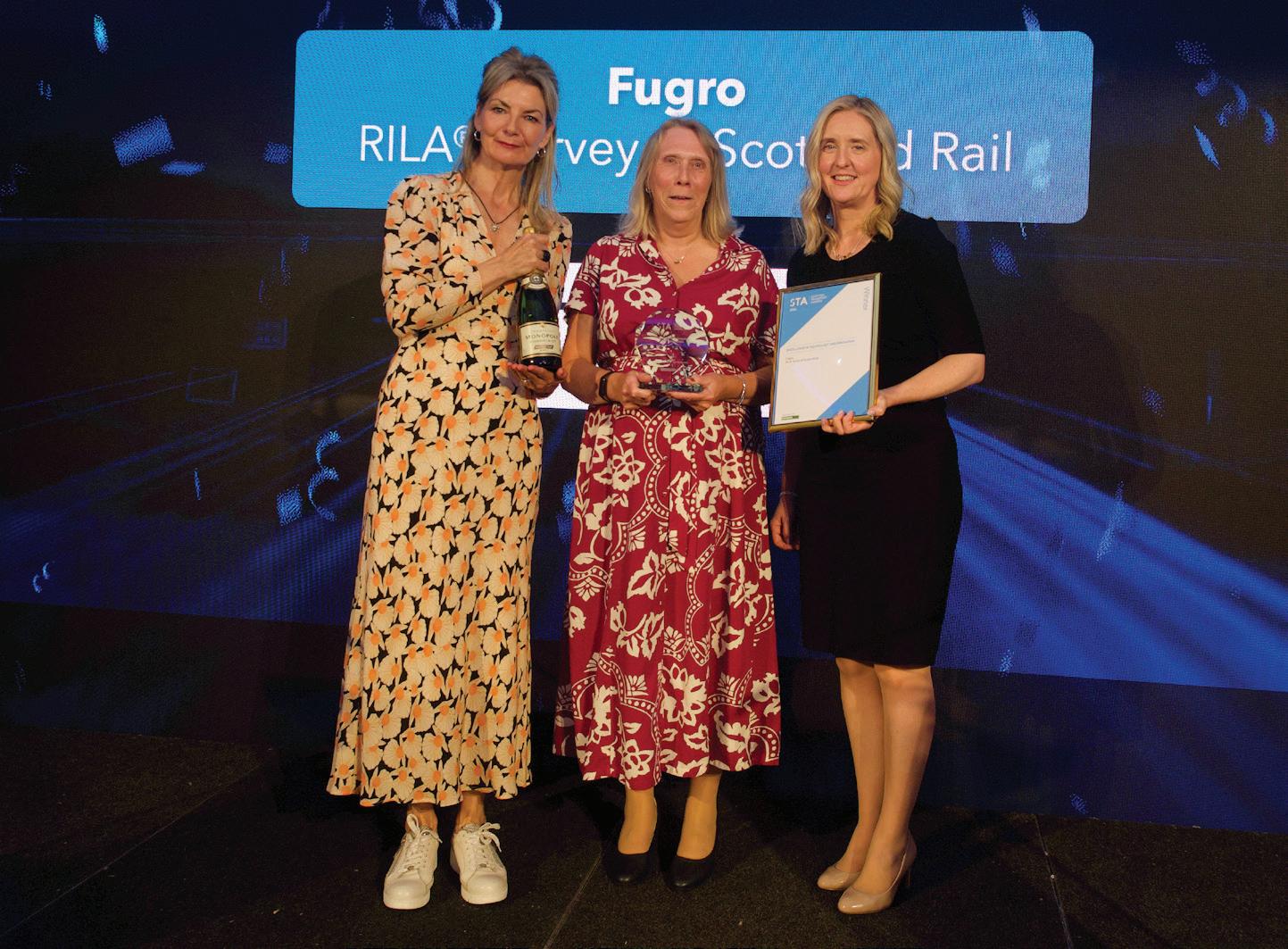
Sponsored by
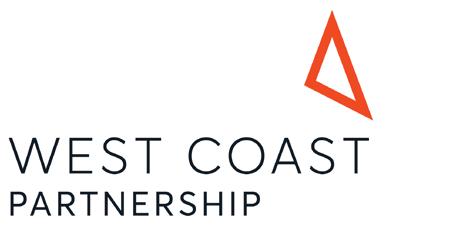
An entry in this category should document how you have employed new technology or a new way of working to bring about great results. Please note that if your project is very recent, we appreciate that results may be limited.
Fugro is transforming the rail industry by enabling rail asset managers to capture and access frequently updated, highquality track and asset data. These valuable engineering insights are available through Fugro's Track Twin, Smart Tamp, and Vegetation Control services, which integrate into maintenance programmes across entire rail networks. Complemented by trackbed solutions, geotechnical engineering, and track engineering services, Fugro RailData® supports all stages of the network lifecycle. Network Rail embarked on updating its structure gauging database to enhance the safety and eficiency of rail operations in Scotland. Covering more than 2,000 miles of track, Fugro utilised its advanced RILA® monitoring system to create a digital model of Scotland’s railway and deliver comprehensive gauging data. Gauging determines the spatial clearance between trains and structures on the railway,
ensuring that trains can safely pass one another and travel through tunnels, bridges, stations, and other lineside structures with suficient clearance.
Fugro's Track Twin ofering facilitates various engineering, maintenance, and asset management applications and aids in designing electrification schemes, crucial for Scotland’s commitment to achieving Net Zero targets for rail passenger services by 2035. Network Rail opted for Fugro's stateof-the-art train-mounted RILA® monitoring system to tackle this challenge. This technology provides engineering-accuracy Geo-data on the rail corridor, minimising disruption to train services and limiting personnel on or near the track.
RILA® was connected to ScotRail passenger trains operating within their regular timetable. Travelling at line speed, RILA® gathered survey data on the tracks and immediate surroundings. Through millions of data points collected using downwardfacing track scanners, lidar laser scanners, and live video footage, Fugro mapped the position and condition of the track and any object in the railway corridor based on absolute and relative track geometry.
Delivered through an intuitive and secure web portal, Fugro integrates 2D and 3D data to provide a Track Twin - a dynamic 3D model of the railway corridor. This allows Scotland's route engineers and asset managers to view their acquired data in a desktop environment. The rich survey data and asset information provided by Track Twin also support the design challenges that lie ahead.
Implementing Fugro's RILA® system and creating the Track Twin have significantly
advanced the accuracy and eficiency of Scotland’s rail network maintenance and management. Network Rail has maintained normal train operations while acquiring crucial data by collecting comprehensive data at line speed with minimal disruption..
The digital model generated by RILA® ensures that gauging data is precise and up-to-date, facilitating safer train operations. This model is instrumental in planning and executing maintenance programmes, optimising asset management, and supporting the design of electrification schemes essential for reducing rail services' carbon footprint.
The Track Twin's integration of 2D and 3D data into a single platform enables route engineers and asset managers to make informed decisions using accurate, real-time data. This capability enhances operational safety and eficiency and provides a robust foundation for future infrastructure projects to achieve Scotland’s environmental goals.
Fugro’s RILA® system demonstrates the feasibility and benefits of gathering extensive geo-data without extensive on-site surveys. This advanced technology sets a new rail network monitoring and maintenance standard, showcasing innovative solutions for modern rail system challenges.
Overall, Fugro's collaboration with Network Rail has significantly improved rail infrastructure management. The project demonstrates how advanced data acquisition and modelling technologies can ensure safer, more eficient, and environmentally sustainable rail operations.
Other shortlisted entries:
Bellrock Technology and Angel Trains: Angels and Data Demons
Clearview Intelligence on behalf of Amey and Transport Scotlan : A78 Pennyburn to Eglinton Speed Compliance Scheme
Cycling Scotland: Cycling Open Data portal
HITRANS: Sustainable Aviation Test Environment (SATE)
SRL Trafic: SRL | SRL Solar PLUS & Haul Route PLUS
Stagecoach Bus: CAVForth, Autonomous Bus No.1 (AB1)
Sustrans Scotland & University of Leeds: Cycle Network Planning Tool (NPT)
Previous winners:
2023: Lothian Buses: LB Roads
2022: AGS Airports Ltd - Project CAELUS
2020: Amey (with Transport Scotland, Strathclyde University and Highland Galvanizers) - Re- Galvanising VRS
2019: Liftshare, Solving commuter problems with data
2018: Network Rail - Automatic Full Barrier Locally Monitored Level Crossing
A submission in this category should demonstrate how efective teamwork has improved transport services or facilities. We will be looking for evidence that working or improved working practices have delivered improvements.
Trams to Newhaven
Edinburgh Trams ofers a safe, reliable, and customer-focused service for local communities and visitors to the city. Focusing on continuing to be an integral part of the future success of Edinburgh and the Lothians by providing world-class, environmentally friendly, and socially inclusive transport, Edinburgh Trams' popularity reached new heights last year following the successful launch of tram services to Newhaven.
The landmark £200m Trams to Newhaven project exemplifies successful partnership working, delivering substantial benefits for Edinburgh, its residents, and the hundreds of thousands of visitors it atracts annually. The project required collaboration to complete the new 4.6-kilometre route with eight stops. Moving from an agreed plan to a completed tramway was a significant endeavour, with Edinburgh Trams contributing at every stage to ensure the new infrastructure seamlessly aligned with the existing network.
The Edinburgh Trams side of the partnership with the Trams to Newhaven (TtN) team was led by Head of Safety and Projects Colin Kerr. His ability to resolve issues quickly and efectively helped to minimise the risk of potential delays and cost increases. Throughout the project, Kerr's team worked closely with the TtN team and contractors to deliver the new line on budget and according to planned timescales. By engaging with up to 30 people via online video meetings, he ensured all members understood their roles and possessed the requisite skills and tools.
Potential hazards were incorporated into a risk register and addressed throughout the design phase to promote safety. This document identified all possible risks and solutions, including guard rails to prevent pedestrian access to specific areas and extra signage at pedestrian crossing points. Safety and operational checks were routinely conducted throughout each phase of the project, including a thorough and complex testing and commissioning phase. Kerr and his team worked diligently to ensure the reliability and safety of existing services were not compromised.
Additionally, a dedicated safety campaign urged the public to stay alert near the
new tramway, especially in areas where pedestrians, cyclists, and motorists would be sharing the roadways with trams for the first time.
Under Colin Kerr's skilled leadership, the team successfully navigated the challenges of the Trams to Newhaven project, ensuring its delivery on time and on budget.
Immediately before opening the Newhaven line, they conducted an extensive testing and commissioning programme to ensure everything was in place for a safe and reliable service. This preparation proved vital, as thousands rely on the tram for daily transportation.
The Trams to Newhaven project has significantly enhanced the city’s transport network, doubling customer numbers over the last 12 months. During the festival season in August, the business recorded its busiest month ever, with around 1,200,000 customer journeys. Even before the new line's oficial opening, patronage figures soared when Harry Styles performed at Scotish Gas Murrayfield Stadium, drawing substantial crowds over two consecutive days. Most recently, an average of 20,000 revellers utilised free, all-night trams during the Hogmanay celebrations.
The delivery of services to Newhaven represents a significant milestone in Edinburgh Trams' history, fiting within a broader vision to create a more connected, greener city. The expanded tramway has immediately benefited the operator and the communities it serves, reinforcing Edinburgh’s appeal as a great place to live, work, or visit.
Edinburgh Trams' commitment to providing a world-class, environmentally friendly, and socially inclusive transport
service is evident in the successful completion of the Trams to Newhaven project. This expansion enhances the city's transportation infrastructure and supports Edinburgh's long-term goals for sustainable urban development.
Commended: HITRANS: HI-BIKE
Other shortlisted entries:
North East Bus Alliance and Bus Partnership Fund
Grampian’s Health & Transport Action Plan
Light Rail UK
Scotland’s Railway: Glasgow-Barrhead Electrification Project
ScotRail : Project Client Steering Group for Motherwell Station and Transport Interchange
ScotRail: Travel Safe Team
Stagecoach East Scotland and St Andrews University: staf and student bus travel partnership
Previous winners:
2023: Transport Scotland: The Death of Her Majesty the Queen, the funeral cortege from Balmoral to Edinburgh
2022: Transport Scotland - Delivering the Transport Plan for COP26
2020: Amey (with Transport Scotland, Strathclyde University and Highland Galvanizers) - Re- Galvanising VRS
2019: Liftshare, Solving commuter problems with data
2018: Network Rail - Automatic Full Barrier Locally Monitored Level Crossing
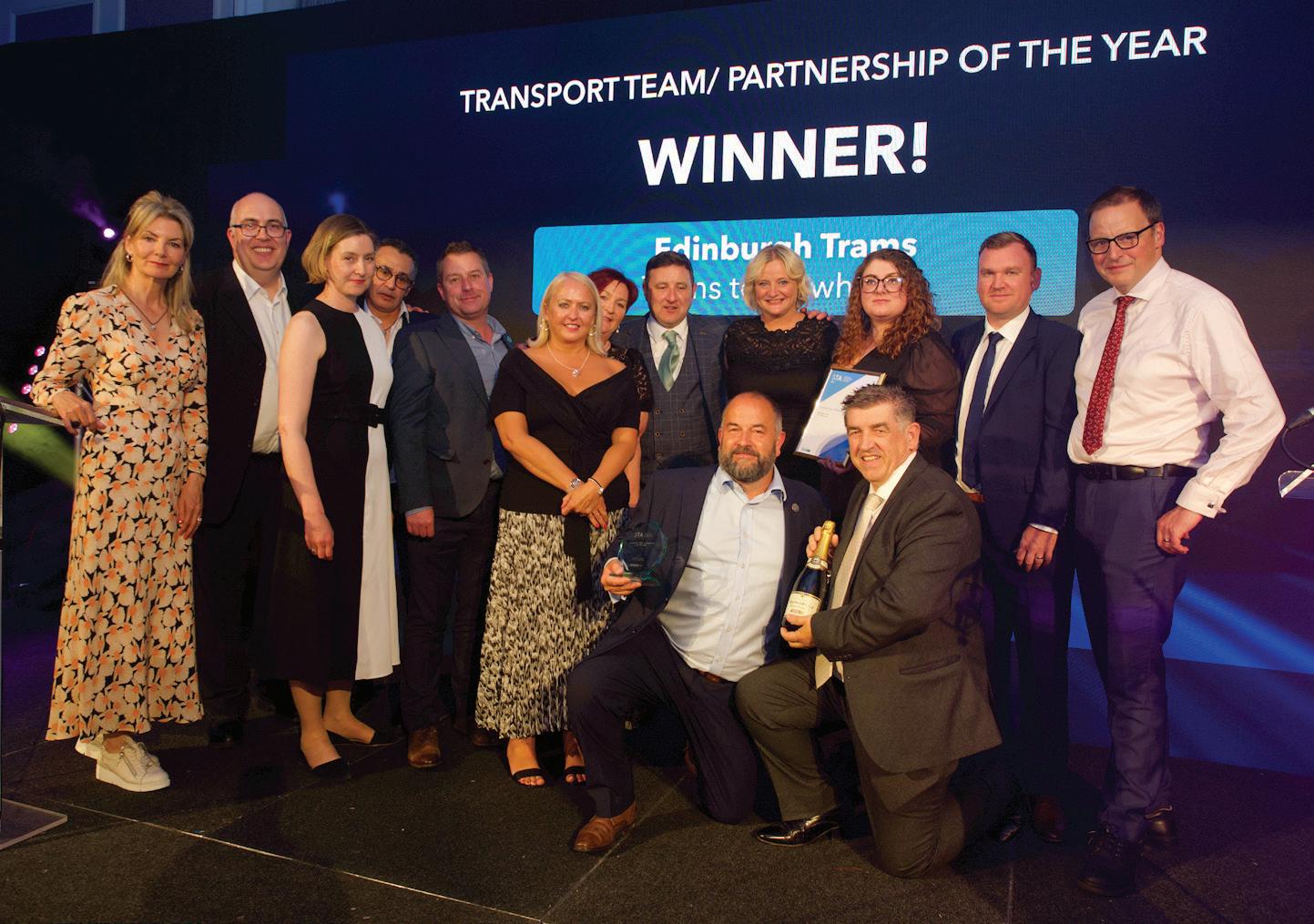
This category covers all areas of transport marketing, including information and promotional work. Clear evidence to show the approach chosen has brought about results, e.g. patronage increases, modal shift or greater awareness of a particular service or facility.
First Bus is one of the UK's largest bus operators and has extensive networks across Aberdeen, Greater Glasgow, and Lanarkshire. In response to the U22 Scheme introduction, the company embarked on a unique 'Free to Explore' campaign. This innovative initiative aimed to promote bus travel to young people, establishing it as a cool and credible option for their day-today travel needs. Over a six-week period, the campaign targeted individuals under 22 and their guardians, delivering a level of creativity that surpassed typical transport company expectations.
The objectives were to increase the number of people using their National Entitlement Card (NEC) on First Bus services by 2%, boost scheme revenue by 3%, achieve 60% card acquisition across the eligible population within operational areas and improve brand reputation metrics. Research and insights into Gen Z preferences shaped the campaign strategy, revealing that young people associate buses with freedom and independence. Despite practical barriers like inconvenience and price, they often dislike using buses. The bus system can seem daunting, and asking for help or
making mistakes can lead to feelings of embarrassment. Young people typically need a nudge to build initial confidence regarding routes, pricing, etiquete, and expectations. These insights informed the creation of a music video, which doubled as an advertisement. Tapping into the Scotish grime scene, the video featured a bespoke rap and a carefully selected cast representing the target audience, with inclusivity and diversity at the forefront. The bold and innovative concept highlighted how the scheme empowered young people to express themselves and gain the freedom to explore.
The campaign's media platforms included Instagram, Snapchat, and TikTok, visited daily by over 55% of young people. Additionally, two bespoke murals by a local artist were commissioned in Glasgow and Aberdeen, positioned as the 'hotest new selfie spots' to encourage further engagement.
The 'Free to Explore' campaign had a significant impact on the target audience, resulting in increased patronage, trip frequency, and card acquisition. The high performance of media and PR eforts indicated a strong resonance with the target demographic. This included 15 pieces of national and regional coverage and an audience reach of 755,800 through influencer partnerships. It garnered 122,502 coverage views, a print reach of 34,446, and 748 social media shares. The total audience reach, combining circulation, MUV, and influencers, was 16,462,546. NEC usage in Scotland increased by 2.7%, and the share of weekly passengers atributed to the scheme grew by 2.67%.
The 'Free to Explore' campaign not only had a significant impact on the target audience but also on First Bus's financial

performance. Revenue grew by 5.5%, averaging an increase of £30,000 per week. Card acquisition in local authority areas served by First Bus increased by 6%, with some areas seeing 11% growth. Brand tracking showed increased ad awareness, aided ad awareness, and purchase intent, with the buzz score rising from -3.5 to +2.6. Among 53 transport brands, First Bus moved from position 37 to 6. 76% of the target audience surveyed viewed the campaign favourably, with 39% discussing it and agreeing it made First Bus more relevant to them.
TikTok and Snapchat exceeded forecast results, with TikTok outperforming by 679% and Snapchat by 795%. Spotify saw 94% of listens fully completed. Total impressions exceeded predictions, reaching 33,135,673, and unique reach equalled 88% of all 15-24-year-olds in Scotland. Trafic to the landing page exceeded 56,000 views, representing over 10% of total unique impressions.
The results demonstrate that the 'Free to Explore' campaign resonated strongly with the target audience and delivered outcomes beyond initial expectations, solidifying First Bus's commitment to innovative and inclusive transportation solutions.ive and inclusive transportation solutions.
Commended:
Stagecoach East Scotland: Bussed“ It, Bossed It” youth campaign
Other shortlisted entries:
Amey: A898 Erskine Bridge Closure Engagement and Communications Strategy
Glasgow City Council: ‘Let’s Look Out for Each Other’ public space awareness campaign
Edinburgh Trams: Glide to the Airport McGill's Bus Service Ltd: Midland Bluebird
ScotRail : Your Ticket Goes Further Than You Think – Regaining the Trust of the Great Scotish Public
Scotish Citylink Coaches: Citylink
Sponsorship with Sean's Scotland
Stagecoach West Scotland - "Let the Good Times Roll" Over 60s Concession
Stagecoach North Scotland: Stagecoach Aviemore Adventurer
Previous winners:
2023: Strathclyde Partnership for Transport: Delivering a Step-Change in Bus Passenger Information and Standards
2022: Sustrans Scotland - #andshecycles
2020: Edinburgh Trams & Scotish Rugby, Successful Partnership Campaign
2019: Edinburgh Trams, Airport Marketing Project
2018: CalMac Ferries - Passenger Safety Video
We're looking for nominations for this award for a frontline member of staf (for example, school crossing patrols, bus drivers, highways inspectors, receptionists) who has gone beyond the call of duty in their role and delivered a beter service. The nominee will have demonstrated a real commitment to their service, and your nomination will need to outline briefly what they have done to deserve this award, supported by statistical or anecdotal evidence. Supporting leters are helpful in this category.
McGill's Bus Service Ltd
McGill’s Bus Group is the UK's largest privately owned bus operator, boasting a fleet of over 850 vehicles and employing 1,800 staf. With depots located in 10 locations, McGill’s facilitates over one million passenger journeys per week. The coaching and private hire division ofers various services, including inter-city routes extending to London, open-top tours, private transport, and day trips. This familyowned business is commited to delivering high-quality, customer-focused service.
In 2021, Xplore Dundee was integrated into the McGill's Group, coinciding with the city's centennial celebration of motorbuses. Reflecting this spirit of innovation, Xplore Dundee launched the Project Boost campaign to enhance bus services and infrastructure. Since 2022, the seasonal Discover Dundee open-top bus tour has been a highlight, ofering visitors a 50-minute circular route featuring landmarks such as the V&A Dundee, the RRS Discovery and the Verdant Works museum.
Xplore Dundee has extended the operating hours of its city centre travel shop and customer service centre, providing enhanced information at busy stops and on buses. The community outreach programme includes depot tours for school groups and the development of 'Xplore Xtras' ofers in collaboration with local businesses.
One of the most notable figures at Xplore Dundee is Mohammad Ramzan, who began his career with Tayside Passenger Transport, its predecessor, in 1978. Known for his friendly demeanour and dedication, Ramzan is now a key figure in the new recruitment campaign and is prominently featured in bus livery. He drives part-time to balance work with family commitments, cherishing time with his grandchildren.
Ramzan's 46-year tenure has made him a beloved and respected team member and one of Scotland's longest-serving bus drivers. His contributions extend beyond driving,


as his engaging personality has made him a mentor and a central figure at the East Dock Street depot. He has been afectionately nicknamed 'Uncle Ramzan' by his colleagues and is highly regarded by customers, who appreciate his dedication and warmth.
Ramzan's long-standing service has seen him take passengers across Dundee, a city renowned for its 'three J's' – jam, jute, and journalism. Generations of customers have grown up riding his buses from the 1970s to the present day. His passion for bus driving remains undiminished, and he continues to inspire with his positive outlook on career opportunities within the company.
The impact of Ramzan's role in the "Did it for Me" recruitment campaign has been significant, leading to a notable increase in applications. His popularity is evident, as he is always willing to cover shifts and assist wherever needed, embodying the supportive and community-focused culture at Xplore Dundee.
In addition to his professional contributions, Ramzan is deeply involved in his local
community and enjoys spending his free time with his family. Although his career spans a period of substantial industry change, his enthusiasm and commitment remain constant.
The joy and comfort he brings to school children and regular passengers underscore his enduring legacy at Xplore Dundee.
Other shortlisted entries:
John MacDonald, Caledonian MacBrayne (North Uist)
John Fry, First Bus Scotland
Kian Greene, McGill's Bus Service Ltd
Kary-Ann McGregor, McGill's Bus Service Ltd
Colin Hunter, Stagecoach East Scotland
Previous winners:
2023: Lindsey Reid, Transform Scotland
2022: Billy Bell, First Glasgow; Stephen Docherty, McGill’s Buses; Marc Macduf, First Glasgow; Dale McDonald, CrossCountry; Stuart Mearns, Edinburgh Tram




575,000


















Suppliers of equipment and services to the rail industries are eligible to enter this category. Entrants should demonstrate the benefits accrued from the use of these products and services, e.g., increased eficiencies, beter integration, improved reliability, decreased crime levels, etc. They may have innovatively applied existing products and services or introduced a new product or service that has traditionally been used outside the rail and road sectors.
NR Civils Asset ManagementEmergency and Reactive Works
AmcoGifen, a leading partner in the design and delivery of multi-disciplinary engineering, construction, and maintenance services in Scotland, is dedicated to providing quality-driven solutions from design and planning to delivery and maintenance. This comprehensive approach ensures minimal disruption to end users, safeguarding stakeholders and the livelihoods of nationwide communities.
AmcoGifen delivers the Civils Asset Management Framework for Network Rail, including reactive emergency works. This framework requires AmcoGifen to respond to site alerts within two hours if necessary. AmcoGifen operates a 24/7 on-call service, 365 days a year to meet this demand. Strategically positioned depots in Cumbernauld, Irvine, Glasgow, Perth, Fort William, and Inverness ensure proximity to key transportation routes, enabling the team to meet the two-hour call-out demand eficiently.
AmcoGifen's teams possess extensive experience with all asset types on the rail network and have local knowledge of most assets. Their comprehensive understanding of infrastructure access and relationships with railway neighbours and stakeholders enhances their operational efectiveness. The scope of work under this framework includes culvert repair, boundary wall works, retaining wall stabilisation, steelwork structure repairs, drainage installation, earthworks, rock stabilisation, scour protection, building refurbishment, historical structures refurbishment, coastal defence, tunnel maintenance, station platform upgrades on a design and build basis.
To execute these projects, AmcoGifen organises railway access, plant equipment, materials, labour resources, design support, local council engagement for trafic management, and specialist subcontractors for ground investigations, shotcrete applications, steel fabrication, etc. The

management team coordinates all these aspects, liaising with Network Rail to update them on work progress, set expectations for timescales, and develop cost-to-completion estimates. They also notify Network Rail of any required land or extended railway access to complete the works.
Since January 2022, AmcoGifen has managed over 500 reactive call-outs, varying from immediate two-hour responses to 28-day assessments and repairs. Over the past two years, they have handled 560 reactive jobs, averaging 3,500 hours spent on monthly call-outs. The outcomes of these works include securing defective assets to eliminate risks to railway infrastructure and the public and reopening rail lines closed due to defects.
Each reactive response involves assessing the defect and developing a plan to address it. Depending on the severity, the local depot may develop the plan, or the assurance team at the regional head ofice may lead the response. AmcoGifen responded to several significant call-outs during the last two winter holidays. In December 2022, the West Highland Line (WHL) and the West Coast Mainline (WCML) were closed due to landslips. AmcoGifen's teams mobilised quickly, assessing the landslips and working with designers to develop and implement solutions. The WHL was closed for six days, and the WCML for four days.
In December 2023, AmcoGifen managed 11 reactive call-outs across Scotland, from Stranraer to Helmsdale, mobilising all depots and spending approximately 4,500 hours on these call-outs. These works addressed landslips, tunnel lining defects, boundary wall collapses, coastal wall
rebuilds, bund replacements, and track washouts. The team’s eforts ensured that Scotland’s railway operations remained safe and reliable.
For their exemplary work, AmcoGifen received a leter of thanks from Network Rail. Route Director Liam Sumpter expressed gratitude for the team's hard work and dedication to ensuring the safety and reliability of Scotland's railway network. This acknowledgement highlights the significant impact of AmcoGifen's comprehensive and responsive approach to civil asset management and maintenance.
In summary, AmcoGifen’s strategic positioning, extensive expertise, and robust management processes enable them to deliver critical infrastructure services eficiently and maintain safety and reliability across Scotland’s railway network. Their proactive and reactive capabilities ensure they can efectively meet the demands of planned projects and emergencies.
Other shortlisted entries:
AmcoGifen: NR Civils Asset Management - Emergency and Reactive Works
Fugro: RILA® Survey of Scotland Rail SPL Powerlines UK Limited: SPL Powerlines UK Ltd - Rail Supplier of the Year
Previous winners:
2023: Story Contracting
2022: Rail Systems Alliance Scotland – RSAS –Alliancing Delivering Results
2020: BAM Nutall – Rail Division
2019: Morgan Sindall, Kerse Road Bridge, Stirling
An entry in this category would provide evidence of excellence or significant improvement in overall performance or facility provision over the past 12 months. KPIs and customer satisfaction results will be particularly relevant as evidence of this.
Glasgow Airport
Glasgow Airport, a key international gateway, serves over 100 destinations across the UK, Europe, the Middle East, and North America through 20 airlines. It supports 5,000 direct jobs and 30,000 jobs nationally, contributing over £1.44 billion (GVA) annually to the economy. Owned by AGS Airports Limited - a partnership between Ferrovial and Macquarie Infrastructure and Real Assets (MIRA) established in 2014Glasgow Airport plays a crucial role in the region's connectivity and economic vitality.
In 2023, Glasgow Airport held its firstever jobs fair, establishing itself as one of the region's largest employers. The event saw participation from 35 campus partners, including airlines, bus companies, retailers, security firms, and ground handlers. Over 2,000 applicants vied for 550 available positions, ensuring the airport was wellstafed for the summer. The event was repeated in January 2024, achieving similar success.
April 2023 marked the return of Scotland's only A380 service on the daily Emirates route, generating significant atention. Additionally, the airport introduced new services to Lisbon, Porto, Larnaca, Hurghada, Southampton, Tunisia, Cape Verde, Verona, Budapest, and Bucharest.
Glasgow Airport continued to lead in sustainability by becoming the UK's first Connected Airport Living Lab in partnership with the Connected Places Catapult. This initiative aims to decarbonise aviation through innovative technologies. A new skills programme is being developed to support the net-zero transition. Construction has commenced on Scotland's largest airportbased solar farm at Glasgow, a 40-acre project expected to generate energy equivalent to powering 15% of Glasgow households upon completion.
Successful flight trials for the CAELUS Project, aiming to establish the UK's first medical drone delivery network, were also conducted last year at Glasgow Airport. In 2023, Glasgow was ranked fifth among UK airports in the annual GRESB sustainability assessment and was one of six airports to achieve Level 3+ status from the Airport Carbon Accreditation (ACA) programme.

To enhance the passenger experience, Glasgow Airport introduced new dining options, including Stack & Still, Greggs, and Pret A Manger. Several airlines implemented a Twilight bag drop service and launched a new valet parking product. The airport's special assistance service achieved a top 'Very Good' status in the CAA's Airport Accessibility Report.
Glasgow Airport experienced its busiest year since 2019, operating at 86% of its 2019 passenger numbers, with over 7.4 million travellers passing through in 2023. The airport anticipates 8.6 million passengers in 2024. As Scotland's leading charter airport, Glasgow saw three major airlines commit to adding extra aircraft in 2024, with Tui increasing from four to six, easyJet from five to six, and Jet2 from seven to eight.
Glasgow Airport maintained smooth operations throughout peak periods without significant challenges or failures.
As part of AGS Airports, Glasgow is making substantial progress toward decarbonising its operations through the Group's Sustainability Strategy. A critical component of this strategy is community engagement and support.
In 2023, the FlightPath Fund distributed over £120,000 to more than 62 charities, local
groups, schools, and clubs in neighbouring communities. Glasgow Airport supported several educational tours and hosted the Institute of Engineering and Technology's (IET) Faraday Challenge Day. Pupils from six regional secondary schools participated, working as real-life engineers to solve an aviation-themed engineering challenge.
The success of the 2023 jobs fair led to its return in January 2024, once again providing a wide range of employment opportunities for people in the West of Scotland. This ongoing commitment to employment, sustainability, and community support underscores Glasgow Airport's role as a vital economic and social hub in the region.
Other shortlisted entries:
AGS Airports: Aberdeen International Airport:
Previous winners:
2023: Glasgow Airport Ltd
2022: AGS Airports Ltd - Aberdeen International Airport
2020: Glasgow Airport Ltd
2019: Glasgow Airport Ltd
2018: Edinburgh Airport
Open to rail, bus, taxi and river/sea passenger service operators. Entries should outline the range of initiatives that the operator has been involved in to improve services and facilities, together with results that have been achieved.
Scotish Citylink operates a comprehensive network of coach services across Scotland, transporting six million passengers annually and serving major cities such as Edinburgh, Glasgow, Aberdeen, and Inverness. ComfortDelGro owns the company in partnership with Scotish operator Stagecoach. In 2023, Citylink enhanced its online booking system and customer information channels, launched new services, and made significant timetable improvements. Key operational developments over the past year include the introduction of new routes and vehicles, as well as improvements to existing services within the network. Citylink launched the 902 service connecting Glasgow, Livingston, and Edinburgh Airport in March. In December, this route was extended to include Harthill Village, Uphall, and Broxburn, with plans to further extend into Edinburgh City Centre by March 2024. Citylink also took over the operation of Service 23 between Springhill and Whitburn, facilitating connections to the 902, 900, and AIR services. Additionally, the 903 service between Glasgow and Edinburgh is set to launch in March 2024, integrating with Service 23 to provide direct links to these cities.
Citylink introduced new vehicles valued at £2 million across three routes. Four new coaches were deployed between Glasgow and Skye, and two new vehicles were introduced between Glasgow and Campbeltown through a partnership with independent operator West Coast Motors. A brand new coach was also launched on the Inverness-Ullapool route, operated by D&E Coaches. In February, 16 state-ofthe-art Volvo 9700 double-deckers, worth approximately £7.2 million, will be added to the Citylink network. The company has also introduced its first electric coach, with plans to add more.
Citylink's 900 service between Glasgow and Edinburgh, operating since 1985, remains one of the country's longestrunning routes. The AIR service continues to ofer the only direct public transport link between Glasgow city centre and Edinburgh Airport. The 'Saltire Cross' network, linking Edinburgh, Glasgow, Perth, Dundee, Aberdeen, and Inverness, will see increased
frequencies from March. The Glasgow and Edinburgh to Aberdeen routes will ofer half-hourly services, providing a 15-minute frequency between Aberdeen and Dundee and Glasgow and Broxden, along with increased journeys between Edinburgh and Inverness. Citylink was Scotland's only major public transport operator to run services throughout the festive season, including on Christmas Day.
Scotish Citylink experienced a 21% increase in passenger numbers over the past year. The company now ofers more services more frequently, efectively meeting customer needs. Several 24/7 services operate between Edinburgh and Glasgow, Aberdeen and Glasgow, and Glasgow and Cumbernauld. The timetable improvements to the Saltire Cross routes resulted in a 17% increase in patronage. The 900 service also saw an 18% increase in patronage over the past 12 months.
The CitylinkAIR network, benefiting from new vehicle investments, recorded a 29% increase in patronage in the past year. Scotish Citylink maintains successful long-standing partnerships and efective stakeholder relationships, including key subcontractors essential for high-quality service delivery. Over the past year, the company conducted successful marketing and social media campaigns, forging links with travel bloggers who promote Citylink services on
their channels. This resulted in audience growth of 62% on Facebook and 36% on Instagram.
In summary, Scotish Citylink continues to expand its services, reaching and connecting more passengers while enhancing convenience and accessibility. The company leads the coach market in Scotland, providing essential transport links and playing a significant role in the country's social, tourist and economic sectors. Through continuous growth and improvements, Citylink remains a vital service provider for millions of people across Scotland each year.
Other shortlisted entries:
Edinburgh Trams
First Bus Scotland
Lothian Buses
McGill’s
Stagecoach North Scotland
Strathclyde Partnership for Transport: SPT Subway
Previous winners:
2023: Edinburgh Trams
2022: McGill's Bus Group
2020: Stagecoach East Scotland
2019: Stagecoach East Scotland
2018: Lothian Buses

An entry in this category covers projects or initiatives that can demonstrate improved access to travel or the travel experience for disabled people. Entries should highlight innovation, the extent to which the proposer has sought to build upon learning through engagement with disabled people, positive team or partnership collaboration, and the extent to which they benefit disabled people in hard-to-reach groups.
Go-Hi and Motability Mobility
Go-Hi, Scotland’s largest Mobility as a Service (MaaS) pilot project, was launched by HITRANS and partners in 2021 to improve transport accessibility in the Highlands. The project covers a diverse region, including a city, several towns, rural areas, and 70 islands. Meanwhile, Motability Operations has enabled mobility for over three million disabled individuals by allowing them to exchange their mobility allowance for leasing a car, scooter, or powered wheelchair through the Motability Scheme.
Motability provides mobility solutions to disabled individuals in the UK. Currently, disabled people (as defined by the Equality Act 2010) make 38% fewer trips than nondisabled individuals, a gap that has remained unchanged for over a decade.
Motability aimed to explore the following questions:
n Can a MaaS app help remove barriers to travel?
n What features does a MaaS app need to cater to users with disabilities?
n Do disabled people require an alternative
to a Motability leased vehicle?
n Are Mobility Credits a viable solution to reduce the transport accessibility gap?
The Go-Hi MaaS app integrates access to multiple transport operators across various modes of transport into a single platform, simplifying mobility access. Users can plan, book, pay, and receive tickets for services from dozens of transport providers in the Highlands region. For the Motability initiative, Motability customers were invited to apply for ‘Mobility Credits,’ a monetary amount usable within the Go-Hi app to purchase mobility services such as train, bus, ferry tickets, or taxi rides.
Motability was set up as a corporate Go-Hi customer to facilitate this, allowing users to buy mobility ‘On account’ without direct payment. The Motability team monitored spend throughout the period. The GoHi customer services team developed onboarding materials, provided training and support to users during the setup and booking processes, and assisted with cancellations or in-journey issues. Data on app usage was collected during the trial period from September to November 2023. Users also provided feedback through questionnaires and focus groups at the end of the trial.
The pilot generated significant interest among Motability customers, with 247 applications received. Due to financial constraints, participation was capped at 100 users, each receiving a £200 allowance to use as an alternative to their Motability vehicle. During the pilot, 130 bookings were made by 16 customers across various modes:
Data from the user survey and focus groups are still being processed, but initial observations indicate a modal shift in action. Anecdotal feedback from the Motability

customer services team during the pilot highlighted the following:
A man who recently underwent surgery and was prescribed a high dose of morphine couldn't drive. His entire Personal Independence Payment (PIP) allowance went to a scheme car, limiting his travel options. Taxis were costly, but the MaaS pilot enabled him to travel safely and afordably. Another participant, a woman with a disabled son, struggled to travel because their carer did not work full-time. The MaaS pilot made her taking him out easier, providing consistency and expanding their options.
Although final results are pending, preliminary findings suggest that Motability customers could sometimes use public or shared transport. This opens the possibility for Motability to ofer a MaaS app as an alternative to a vehicle for individuals who cannot or do not want to drive. The Go-Hi project team and Motability are exploring the potential for a broader project.
The Go-Hi app is undergoing redevelopment to meet WCAG 2.2 standards, ensuring digital accessibility and supporting all users' ongoing and future needs.
Commended:
Badenoch & Strathspey Community ConnXions: Badenoch & Strathspey Community ConnXions
Other shortlisted entries:
Grease Monkey: Wheatley Project
Lothian Buses: Jason’s Journey
McGill's Bus Service Ltd: McGill's RNIB Training Programme
Scotland's Railway (Network Rail & Scotrail) and Story Contracting: Port Glasgow Access For All
Scotland's Railway (Network Rail Scotland, & ScotRail) and CPR Civil Engineering: Cardonald Railway Station Access Improvements
ScotRail: Glasgow Station Bus Link
ScotRail: Upgraded wheelchair and cycle space livery
Previous winners:
2023: Lothian Buses
2022: Lothian Buses – Lothian Accessibility
2020: Inverness Airport
2019: Glasgow Airport Ltd - Ensuring Every Passenger Enjoys Their Journey
2018: Neatebox Ltd, Scotland Transerv, and Transport Scotland - Neatebox Buton
App to improve road safety for disabled pedestrians in Largs
2017: Transport Scotland - Scotland
Accessible Travel Framework
2016: Scotish Borders Community Transport Services

Designs entered into this category should demonstrate promising results. There should be evidence that the design has potential for future flexibility and is environmentally and economically sustainable. Excellence should be demonstrated in innovation, invention, and originality - it could be a design that is the first of its kind in the country and shows that it adds value and stands out above the rest.
City Centre West to East Link and Street Improvements Project
The City Centre West to East Link and Street Improvements project (CCWEL) is a significant infrastructure initiative undertaken by the City of Edinburgh Council. This project is managed by the active travel team, dedicated to fostering healthier, more accessible environments for walking, wheeling, and cycling while enhancing public spaces along some of Edinburgh's busiest streets. The CCWEL project aligns with the City Mobility Plan, envisioning a clean, connected, and net-zero carbon future, and supports the Actions for Delivering Active Travel.
The CCWEL project aims to establish a high-quality, dedicated cycleway traversing the centre of Edinburgh, extending from Roseburn to Leith Walk via Haymarket. This transformation is designed to improve the nature and functionality of these streets. The newly constructed cycleway caters to less confident cyclists and those wary of navigating busy trafic. This route is
part of the National Cycle Network (NCN) Route 1. It will link with other planned city centre active routes, including the George Street and First New Town project and the Meadows to George Street route, as part of the Edinburgh City Centre Transformation. The CCWEL project adheres to local and national best practice guidelines. The design integrates the needs of individuals with disabilities or impairments, as outlined in the integrated impact assessment. Key features of the design include:
n Segregated cycleway
n Improved pedestrian and cycle crossing facilities
n Upgrade of the drainage network along the route
n Enhancement of street lighting
n Cyclist and pedestrian priority at key junctions
n Upgrade of junctions
n Contra-flow cycle provision on one-way streets
n Reduced carriageway widths
n Raised tables at side road crossings
n New cycle parking facilities
n Removal of redundant street furniture to reduce street cluter
n Carriageway resurfacing
n Amendments to on-street parking
n Wider pavements
n Dropped kerb crossings
n Continuous footways with raised tables over side roads
n New landscaped areas, including trees, grassed areas, and benches
Beyond the cycleway, the project includes placemaking enhancements at key locations, creating more spaces for people to sit and spend time, and providing additional reasons to visit Edinburgh’s outdoor
areas. Key locations benefiting from these improvements include:
n Old Colt Bridge
n Haymarket Terrace
n Melville Street, where central parking has been removed
n Bishop’s Walk outside St Mary’s Cathedral
As of 2015, the CCWEL project is projected to increase cycle journeys along the afected corridor by 88%, from 1,675 to 3,142 trips. The forecasted benefits, including health and economic advantages, are valued at over £20 million. A comprehensive monitoring plan has been established to assess the scheme's impact. This plan will evaluate various aspects before and after implementation, including:
n Trafic levels and safety
n Environmental impact
n Economic outcomes
n User satisfaction across diferent groups
Despite initial controversy over perceived parking, retail, and congestion implications, initiatives such as Rejuvenating Roseburn have fostered greater community buy-in. Baseline monitoring in 2021 revealed that 49% of respondents supported the scheme, 11% opposed it, and 40% were unsure.
The project's success is reflected in how the space is now utilised. Shops and cafes have started using the expanded pavements for outdoor seating. Old Colt Bridge's new public realm space has become particularly popular, especially during events like the Christmas tree lighting ceremony. The Active Travel Team held a Dr Bike session, joined by Police Scotland and Spokes, in the new public space outside the Four Points by Sheraton hotel. This event provided bike repairs and gathered helpful feedback on the latest cycle route, with many parents expressing satisfaction with leting their children ride to school.
Ongoing cycle counts and monitoring of the continuous footways, including video analysis of interactions between diferent users, will be reported in the near future.
Story Contracting: Burton Underpass & Sensory Garden
Other shortlisted entries:
Grease Monkey: Wheatley Project
Scotland’s Railway: Glasgow-Barrhead
Electrification Project
ScotRail: Upgraded wheelchair and cycle space livery
Previous winners:
2023:ScotRail: Highland Explorer: Unlocking active travel on the West Highland Line 2022:Scotland’s Railway - Glasgow Queen Street station redevelopment





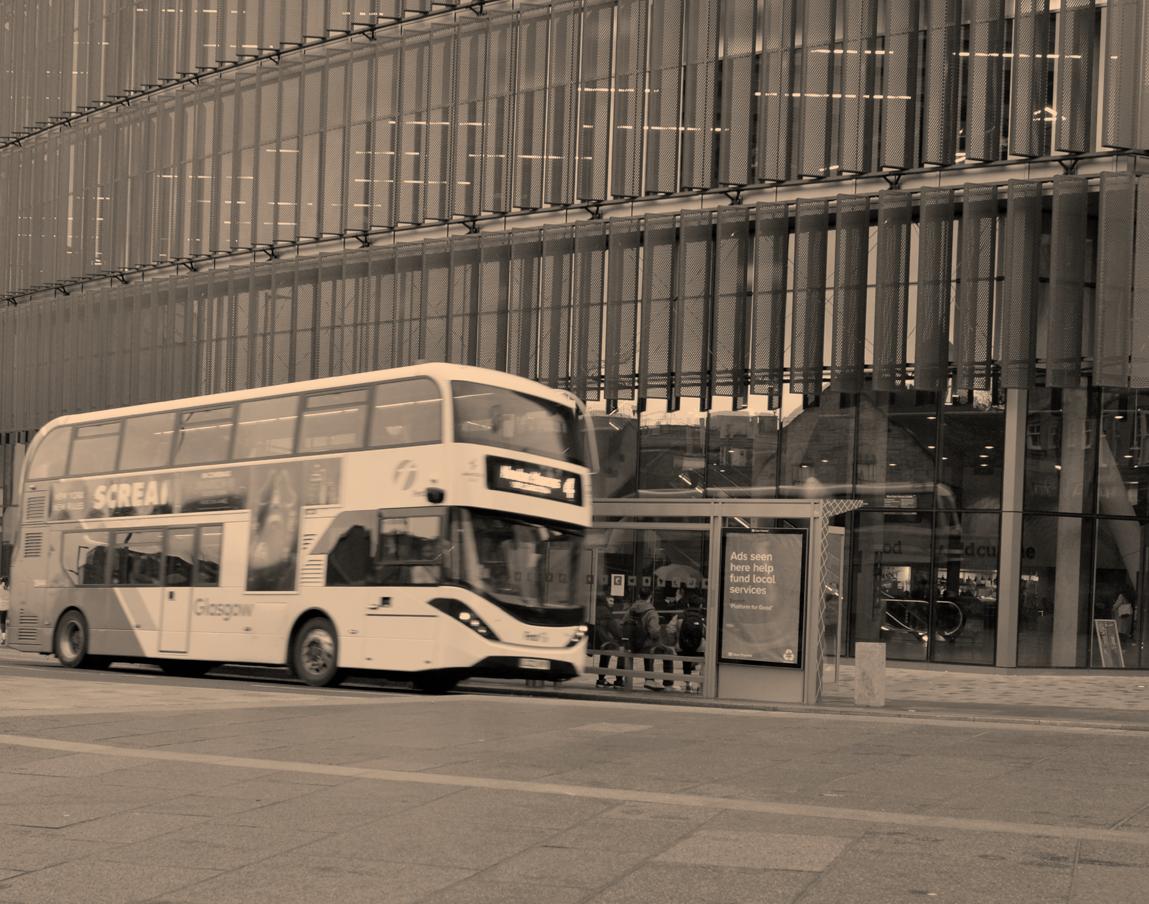
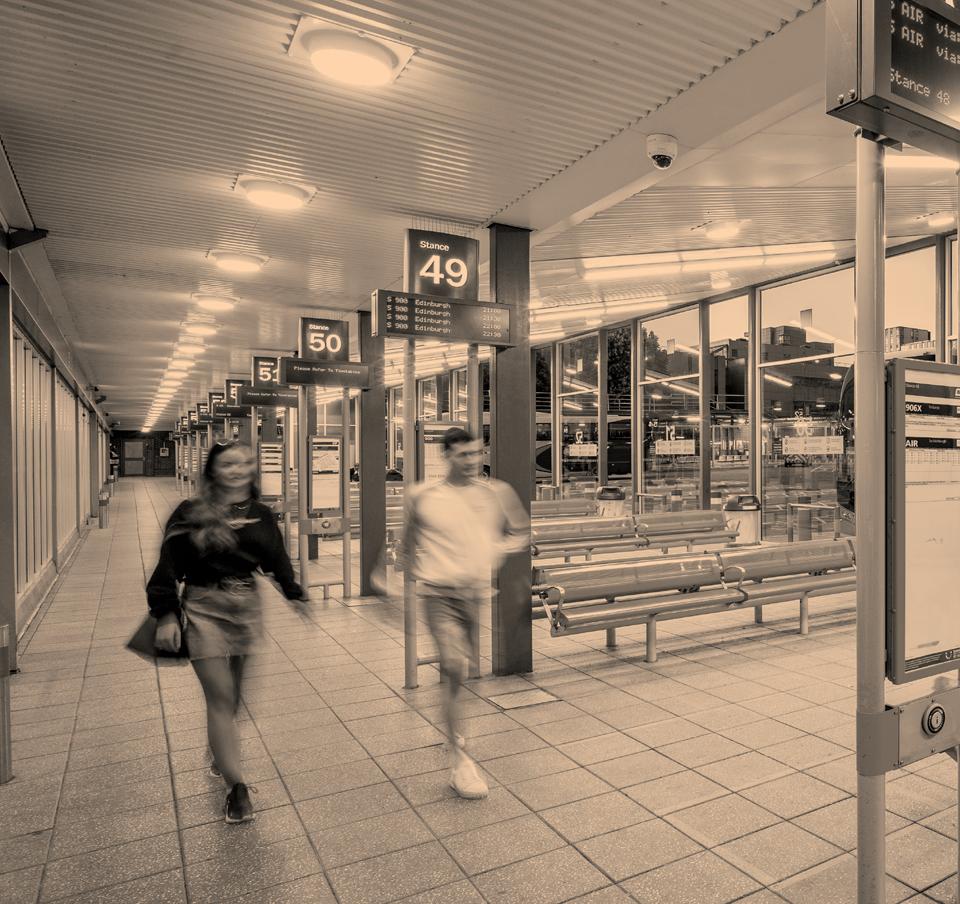


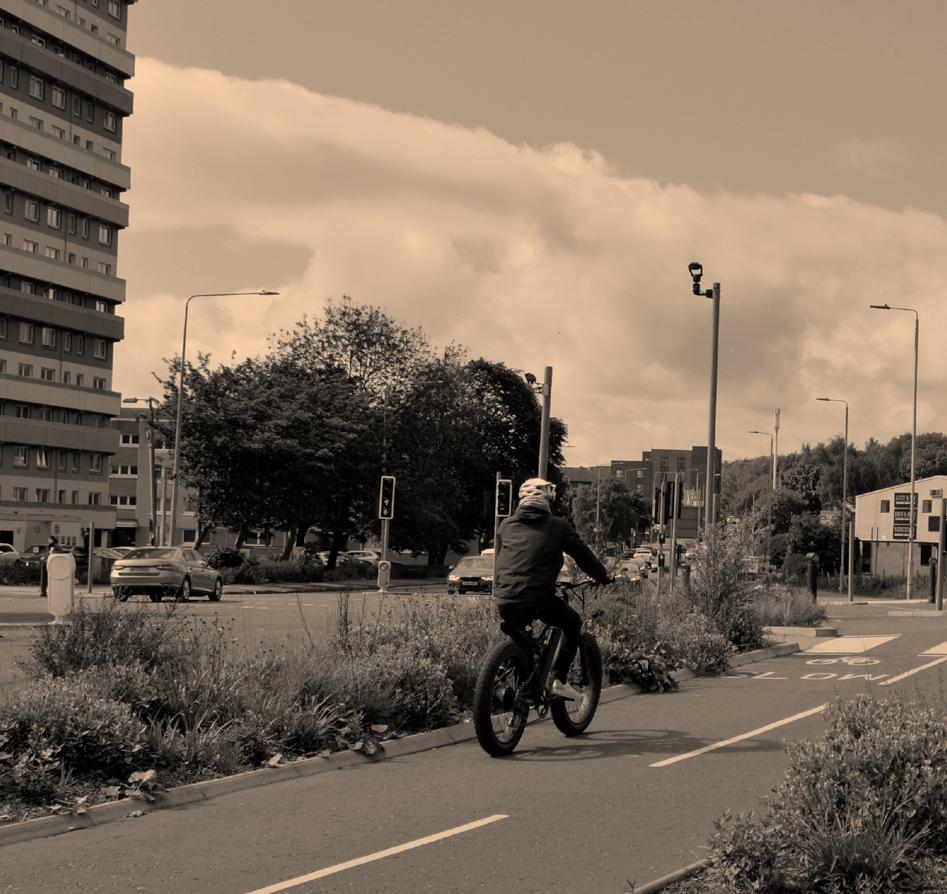







A submission in this category should demonstrate progress and improvement across sustainable transport policy areas supported by measurable outcomes. We seek evidence that public transport patronage levels and/or mode shift and customer satisfaction ratings are moving correctly, albeit in a post-Covid context. Submissions should include the approaches being utilised to atract people back to local transport and what approaches are being used to ensure accessible and afordable travel is available for all. Evidence on improving public health through increased active travel infrastructure and networks, decarbonised fleets (e.g. electric buses) and road fatality statistics will also be necessary.
Strathclyde Partnership for Transport (SPT) serves as the Regional Transport Partnership (RTP) for the west of Scotland and is the largest of Scotland’s seven RTPs. As a partnership of 12 councils, SPT is responsible for the development of the Regional Transport Strategy (RTS) and operates a wide array of transportation services, including local bus services, the Glasgow Subway, specialist bus services like MyBus DRT, Community Transport, and innovative ticketing solutions.
SPT’s core responsibilities encompass planning the regional transport network, formulating policies and strategies for public transport solutions, active travel, ticketing, project delivery, and infrastructure development. SPT has achieved significant milestones in the past two years, continuing to provide sustainable and afordable travel options for communities across the region.
In 2023, SPT published a new RTS outlining a vision for transportation development over the next 15 years. This strategy addresses modern challenges such as climate change, inclusive economic growth, and ensuring equitable life opportunities for all residents. SPT has continued to deliver major bus and rail infrastructure projects and invest in active travel initiatives. However, the most ambitious project is the multi-billion-pound Clyde Metro network, aimed at transforming public transport over the next 30+ years and unlocking economic growth.
SPT operates the Glasgow Subway, which is currently undergoing modernisation. This includes the introduction of new trains, state-of-the-art communications and signalling systems, and a new operational control centre. SPT’s bus stations are crucial transport hubs, enhancing connectivity and accessibility. The supported bus network serves communities with limited
or no commercial services, such as rural and isolated areas and economically disadvantaged regions where low car ownership necessitates greater reliance on bus services.
The MyBus service provides door-todoor transportation for individuals with mobility issues or those who have dificulty accessing mainstream services. SPT’s capital programme has delivered infrastructure improvements supporting bus network users, including new stops, raised kerbs, shelters, real-time passenger information, and roadside timetable information in line with new Bus Information Standards.
The new RTS, titled ‘A Call to Action,’ received approval from Scotish Ministers in July 2023. Future plans, projects, and developments will align with this strategy. Several commitments are already in progress, including creating a new Regional Bus Strategy and exploring bus service delivery models. This makes SPT the first public body to investigate the bus powers within the 2019 Act.
In December 2023, SPT reached a significant milestone by introducing two new state-of-the-art trains into service. More trains will be added in 2024, completing a fleet of 17. Post-COVID-19, SPT has focused on passenger safety, launching campaigns to emphasise public transport safety. Notably, SPT is the only transport operator in Scotland to achieve a 100% return to full patronage following the pandemic.
In late 2023, SPT was designated the lead partner in advancing the Clyde Metro Case for Investment. Progress includes establishing governance arrangements and initiating a Case for Change and Options Appraisal. Collaborating with operators, SPT has advanced the modernisation of ZoneCard, transitioning to smartcard form
for improved convenience and security and introducing a more flexible range of tickets with a simplified zone structure.
SPT has begun implementing key recommendations after reviewing MyBus services in 2022, including user consultations. These include simplifying registration and new scheduling arrangements to confirm journeys more quickly, which have been well received.
In June 2023, the Transport Minister oficially opened the redeveloped Motherwell Rail Station and bus Interchange. This redevelopment, which resulted from several years of partnership between SPT, rail partners, and North Lanarkshire Council, significantly transformed town centre transport infrastructure.
SPT’s eforts to enhance transportation in the west of Scotland demonstrate a solid commitment to sustainable, inclusive, and innovative transport solutions. Through ongoing projects like the Clyde Metro, the modernisation of the Glasgow Subway, and improvements in bus and rail services, SPT continues to work towards a connected and accessible future for all residents.
Other shortlisted entries:
Aberdeen City Council
Aberdeenshire Council
City of Edinburgh Council
Glasgow City Council
South Lanarkshire
Previous winners:
2023: ScotRail: Highland Explorer: Unlocking active travel on the West Highland Line 2022: Scotland’s Railway - Glasgow Queen Street station redevelopment


Transport planning and developing transport plans are the cornerstone of sustainable, integrated and eficient transport networks. This category is open to national, local, and regional authorities and agencies, including any engineering/ planning consultancies partnerships. Plans must have been published/compiled in the last year and can focus on entire multimodal networks or individual areas such as Active Travel or bus networks. Entries should show consideration and alignment with other policies and strategies, including the National Transport Strategy and demonstrate how transport planning contributes to the planning of diferent portfolios, including economic development, land use planning, climate change, as well as health and education.
Edinburgh's City Mobility Plan and Our Future Streets
The City of Edinburgh Council's Placemaking & Mobility team, established in 2022, comprises a dedicated multidisciplinary group commited to developing and implementing policies and projects to make the Scotish capital healthier, greener, and more liveable.
Over the past 12-18 months, the Placemaking & Mobility team has been focused on delivering a fully integrated, place-based approach to transport planning and implementation, guided by the City Mobility Plan (CMP). This process was informed by citywide engagement in the summer of 2023, which aimed to understand the city's top priorities and the challenging decisions required to achieve the ambitious
targets for net zero emissions, car kilometre reduction, and Vision Zero.
The work comprises four interrelated elements, developed in parallel, which were collectively presented and approved by the Transport & Environment Commitee on February 1, 2024:
1. Review of the CMP (2021) – the local transport strategy.
2. Our Future Streets – a Circulation Plan for Edinburgh.
3. Expansion of the tram network to connect Granton with Bioquarter and beyond.
4. West Edinburgh Transport Improvements Programme.
The first review of the CMP focused on ensuring alignment with national, regional, and local policies and public/stakeholder priorities, creating a new, fully integrated Implementation Plan. This review moved away from traditional mode-based action plans and introduced a framework for monitoring progress against expanded Key Performance Indicators (KPIs).
A fundamental commitment of the CMP is to deliver a strategic approach to street space allocation, prioritising sustainable modes of transport and reducing conflicts. The "Our Future Streets" initiative draws inspiration from cities like Ghent. The ambition is to deliver integrated, equitable, place-based improvements that maximise positive impacts and support the goal of reaching net zero by 2030. This initiative aligns with national and regional policies, including the National Transport Strategy and National Planning Framework 4, and integrates with Council plans.
The CMP received high commendation from the Scotish Transport Awards 2022 following its approval in 2021. Its success is evident in the development and delivery of innovative and equitable projects to meet
net zero, car kilometre reduction, and Vision Zero targets. By the end of 2023, significant milestones were achieved, with notable performance against most CMP KPIs. Edinburgh is the first Council nationally to approve a target to reduce car kilometres by 30% by 2030, surpassing the national/ regional target of 20%. This target is embedded in other Council policies, including the Climate Strategy and City Plan 2030, reinforcing the rationale for sustainable development. Between 2019 and 2022, car kilometres were reduced by 7%, equating to 164 million fewer kilometres, and carbon emissions from road transport decreased by 8% between 2019 and 2021, translating to 53,100 fewer tonnes of carbon dioxide.
The CMP review led to the significant streamlining of the transport planning approach, integrating individual action plans for active travel, public transport, road safety, air quality, and parking into a comprehensive CMP Implementation Plan. This new plan ensures place-based delivery, supported by the "Our Future Streets" initiative, reflecting feedback from the summer 2023 consultation. The updated Implementation Plan features a suite of multimodal and placemaking actions to ensure integrated and rapid delivery of impactful projects to meet commited targets. The number of actions increased from 37 to 112 since the original Plan, with clarity on the project type each action falls under, such as 'Street Transformation,' 'Liveable Neighbourhoods,' 'Major Junctions and Crossings,' and 'City Operations.'
Additionally, 21 new CMP KPIs have been introduced, bringing the total to 36 to provide greater depth in measuring progress. This expanded set of KPIs allows for comprehensive monitoring of the implementation and efectiveness of the strategies outlined in the CMP.
The Placemaking & Mobility team's commitment to creating a healthier, greener, and more liveable Edinburgh is evident in their strategic, integrated approach to transport planning and delivery, ensuring the city meets its ambitious environmental and social goals.
Commended:
Glasgow City Council: Glasgow's Active Travel Strategy 2022-2031 and supplementary strategies
Other shortlisted entries:
Aberdeenshire Council: Championing Successful Community Engagement 65
Arup: Tactran Regional Active Travel Network
Stantec: Dundee - Bell Street Sustainable Transport Hub and Active Travel Routes
This prestigious award honours those who have demonstrated exceptional leadership, innovation, and dedication to improving Scotland's transport infrastructure, services, and sustainability. The judges nominate the winner.
Hannah Ross is the Head of Major Projects and Commissioning at the City of Edinburgh Council. She has been pivotal in the success of the Trams to Newhaven project, among other essential work.
Hannah came into the public transport by accident. She was the lead solicitor for City of Edinburgh Council on the project when the role of Senior Responsible Oficer (SRO) came up. She found the project interesting and had been very involved in several key decisions up to that point, so when the job came up, she suggested to the Director that he should consider her for it. He encouraged her to apply, and shortly afterwards, she took on the SRO role.
The Outstanding Contribution Award was presented to Hannah by her former colleague, Daisy Narayanan, also a member of the judging panel.
Until recently, Daisy, the council’s Head of Placemaking and Mobility, said that Hannah had shown vision, leadership, and commitment to deliver one of Scotland’s major projects.
“I first met her around a decade ago and was immediately taken by her intellect, her calm manner and strength of character,” said Daisy. “A lawyer by background with
experience on major development schemes, someone with a real understanding of the essentials, contracts, risk, public/private partnerships - she was brought in to lead a critical and complex transport project in Edinburgh.
“Over the years, it has been brilliant watching her grow in her role, bringing the ethos of partnership and collaboration, and - last year - her success in delivering this project ‘on time and on budget’.”
“But more importantly, it has been brilliant to watch her navigate complicated issues with grace and with integrity. I have had the pleasure of collaborating with her on key strategic projects in Edinburgh and am proud to call her my colleague and friend.”
After presenting the award to her former colleague, Hannah Ross, Daisy was surprised to find that this year there are two winners of the Outstanding Contribution Award - and the second one was her. Daisy’s fellow judges felt that it was right that her contribution to Scotish transport should also be recognised.
Daisy joined The Crown Estate this year as Public Realm Director. She was previously Head of Placemaking and Mobility at the City of Edinburgh Council, where she lead on delivering a city-wide integrated approach to transport and placemaking. She spearheaded schemes such as CCWEL (City Centre West to East Link), George Street and First New Town.
Daisy trained as an architect and urban designer, and over the last decade, her work has focused on sustainable transport and

climate action. Drawing on her previous experience working in India, Singapore, England, and Scotland, Daisy passionately believes in the importance of creating inclusive places for people: places that reflect and complement the communities that live in them.
Seconded to the council from Sustrans, she led the successful development of Edinburgh City Centre Transformation, a pioneering 10-year plan to create a vibrant, truly people-friendly city centre.
She was recently awarded an MBE for services to inclusive urban planning and elected to the Fellowship of the Royal Society of Edinburgh.
Alison Irvine, Chair of the judging panel and Interim Chief Executive at Transport Scotland, presented Daisy with the award. Alison said she was delighted to present the award to another inspirational female leader in the transport sector.
Alison said: “[Daisy is] someone who has demonstrated real strategic vision, drive and resilience to change the outcomes for transport in Scotland - changes which will improve the lives of the people of Scotland.
“I first met her in 2018 and was immediately taken by her passion for creating great places and her determination in the face of some significant resistance to a transformation programme for our capital city.”
Previous winners:
2023: Valerie Davidson, Strathclyde Partnership for Transport
2019: Neil Gellatly, Dundee City Council
2017: Andrew Burns, City of Edinburgh Council














proud of our people proud of what we do and proud to be recognised amongst the best in our industry










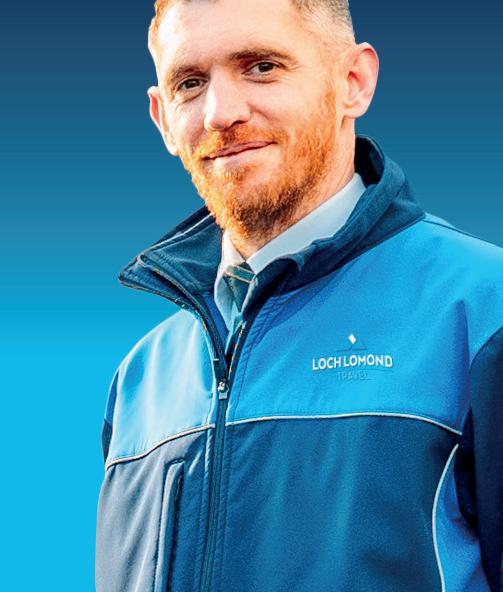



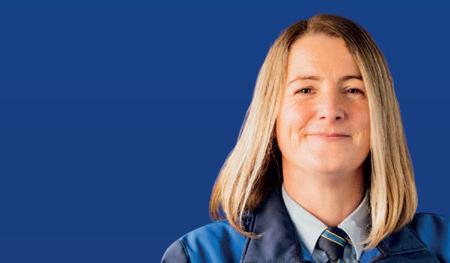













































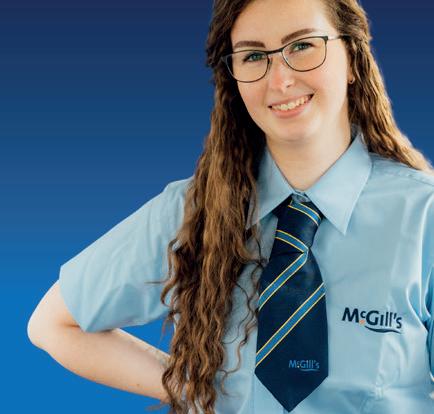













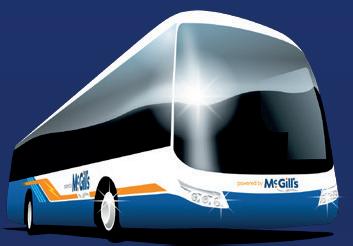











This award celebrates the exceptional contributions of those who have dedicated their lives to advancing and shaping transport in Scotland with an unwavering commitment to excellence, innovation, and progress. The judges nominate the winner.
With a 30-year background in the transport sector, Ralph Roberts now serves as the CEO of McGill's Bus Group.
He joined the company in 2010 after a chance encounter at a rugby match with its owners, Sandy and James Easdale. Since then, he has overseen a tenfold expansion that has seen McGill's become the UK's largest independent bus operator.
Born and raised in Coatbridge, Roberts studied Engineering at the University of Strathclyde and Glasgow Caledonian University. He spent 10 years in haulage, logistics and industrial services with TDG and Rentokil Initial before joining Arriva plc, where he accumulated significant experience across the UK and European
bus and rail sectors. His final position with the group saw him return to Scotland as Managing Director of Arriva Scotland West.
Under Roberts' leadership, McGill's has grown from a 140-employee operation to one employing more than 2,000 individuals, marking a period of significant expansion and development for the company.
His expertise and leadership have been recognised through various prominent roles. Within Scotland, this includes being past Chair of the Freight Transport Association Scotland, the Confederation of Passenger Transport in Scotland, VOSA Operator Liaison Commitee Scotland, the Scotish Smart & Integrated Ticketing Steering Group and Gourock Community Council. He currently serves as Chair of Traveline Scotland.
Additionally, he has served as President of the Confederation of Passenger Transport UK, representing bus and coach operators in Westminster.
Roberts is known for his expertise in legal negotiations, procurement, contractual maters, and vehicle and rolling stock procurement. His strategic vision includes overseeing the integration of business management and back-ofice systems from
concept to completion. His role at McGill's has also seen him engage in mergers and acquisitions, driving the company's growth through innovation and strategic planning.
McGill's prides itself on delivering high-level customer service and investing significantly in new vehicles and driver training. The group worked closely with the Prince's Trust on the 'Get Into Bus Engineering' scheme to allow younger workers the opportunity to become engineers with McGill's. The programme has now been extended with in-house engineering training courses at their academies. The company is also accredited as an Investor in Young People.
Through his leadership at McGill's, Roberts has cemented his reputation as a transformative figure in the transport sector. He is known for his strategic vision, operational excellence, and dedication to innovation and service quality.
Previous winners:
2023: Neil Johnstone, CIHT
2020: Robert Andrew, Stagecoach
2019: George Mair, CPT Scotland
2018: Eric Stewart, SPT
Projects entered into this category need to demonstrate good results. They could be the first of their kind or projects that have been done before but have been approached diferently.
Project CAELUS - AGS Airports
Project CAELUS, led by AGS Airports in partnership with NHS Scotland, is a pioneering initiative to establish the first national drone network for transporting essential medical supplies throughout Scotland. This ambitious project, CAELUS (Care & Equity – Healthcare Logistics UAS Scotland), is partially funded by the UK Research and Innovation (UKRI) Future Flight Challenge and brings together 16 partners commited to revolutionising healthcare logistics, especially for remote communities.
Project CAELUS addresses the challenges of delivering healthcare services across Scotland's vast rural landscape, which can lead to treatment inequity. CAELUS aims to mitigate this by using drones to deliver vital medical supplies. Through live and digital flight demonstrations, CAELUS has demonstrated that a network of multiple drones can safely integrate with existing flight operations, addressing regulatory requirements and social concerns.
The project involves developing the necessary ground infrastructure to recharge drones and the systems to control them during flights. A crucial aspect of CAELUS is designing pathways that ensure drones can safely share airspace with civil aviation. The project also emphasises public safety, security, and noise levels, providing a comprehensive approach to integrating drones into the existing transport infrastructure.
In October 2023, Project CAELUS achieved a significant milestone by conducting live flight trials. These trials involved flights between Glasgow Airport and NHS Golden Jubilee in Clydebank, marking an important step towards integrating drones into modern airspace and enabling their safe use at scale within Scotland's airspace. The collaborative eforts of all partners resulted in a robust safety case for flights in a busy airport environment, which can be adapted for future sites.
The live flight trial represented the culmination of months of collaboration within the consortium and with the Civil Aviation Authority. This initial beyond-visualline-of-sight project has paved the way for four additional live flight trials scheduled for 2024 across various regions of Scotland, including Ayrshire and Arran, Grampian,
Lothian and the Borders, as well as Orkney and Shetland.
NHS Scotland views the adoption of Unmanned Aerial Systems (UAS) or drones as a transformative opportunity to enhance patient experiences and reduce the impact of trafic congestion and CO2 emissions. Current road-based systems involve over 1 million miles of fuel consumption annually. A drone-based network would significantly reduce mileage and provide substantial time savings, ultimately improving patient outcomes. Specific use cases identified with the NHS for future testing include:
n Reducing sample-to-laboratory time improves clinician decisions, such as selecting targeted antibiotics.
n Reducing the identification and delivery time for cross-matched blood products.
n Enabling local administration of chemotherapy, following preparation at a specialist laboratory and delivery within a time-controlled window.
Project CAELUS also aims to inform the skills and regulatory pathways required to develop this emerging market in the UK. Leveraging the supply chain of project partners, CAELUS is expected to create approximately 750 jobs, including 250 indirect jobs throughout the supply chain and associated stakeholders. This initiative is projected to deliver a £12.75 million boost to the Scotish economy, diversifying sectors such as construction, infrastructure, manufacturing, and aviation.
The live flight trials allowed the testing of processes and procedures within a controlled aviation environment. These trials also evaluated how a specifically designed app could enable NHS staf to order items within a national network, ensuring the practical application of the drone network in real-world scenarios.
In summary, Project CAELUS is a groundbreaking initiative demonstrating the potential of drone technology to transform healthcare logistics in Scotland. By addressing regulatory, safety, and operational challenges, CAELUS is set to pave the way for the widespread adoption of drones in healthcare delivery, enhancing accessibility and equity across the region.
Other shortlisted entries:
City of Edinburgh Council: Our Future Streets
Edinburgh & South East Scotland City Region Deal: The Workforce Mobility Project First Bus: Under 22s ‘Free to Explore’ Campaign
Glasgow City Council: STARS School Travel and Road Safety
Glenfarg Community Transport Group: The 55 Bus
Heriot Wat University: SOAST‘Suburban-fringe 'on-demand' algorithm based shared transport’
Sustrans Scotland & University of Leeds: Cycle Network Planning Tool (NPT)
Previous winners:
2023: The Highlands and Islands Transport Partnership (HITRANS): Go-Hi MaaS Pilot Project
2022: Sustrans Scotland - Minecraft St Philomena's Primary School
2020: BEAR Scotland, Transport Scotland and BEAR Scotland – A83 Rest and Be Thankful Catch-Pits and Glen Kinglas Rock Bunds
2019: Jacobs, Transport Scotland, Scotland TranServ & Sibbald - VR Site Safety
2018: Amey - Re-Galvanising Vehicle Restraint Systems (VRS)
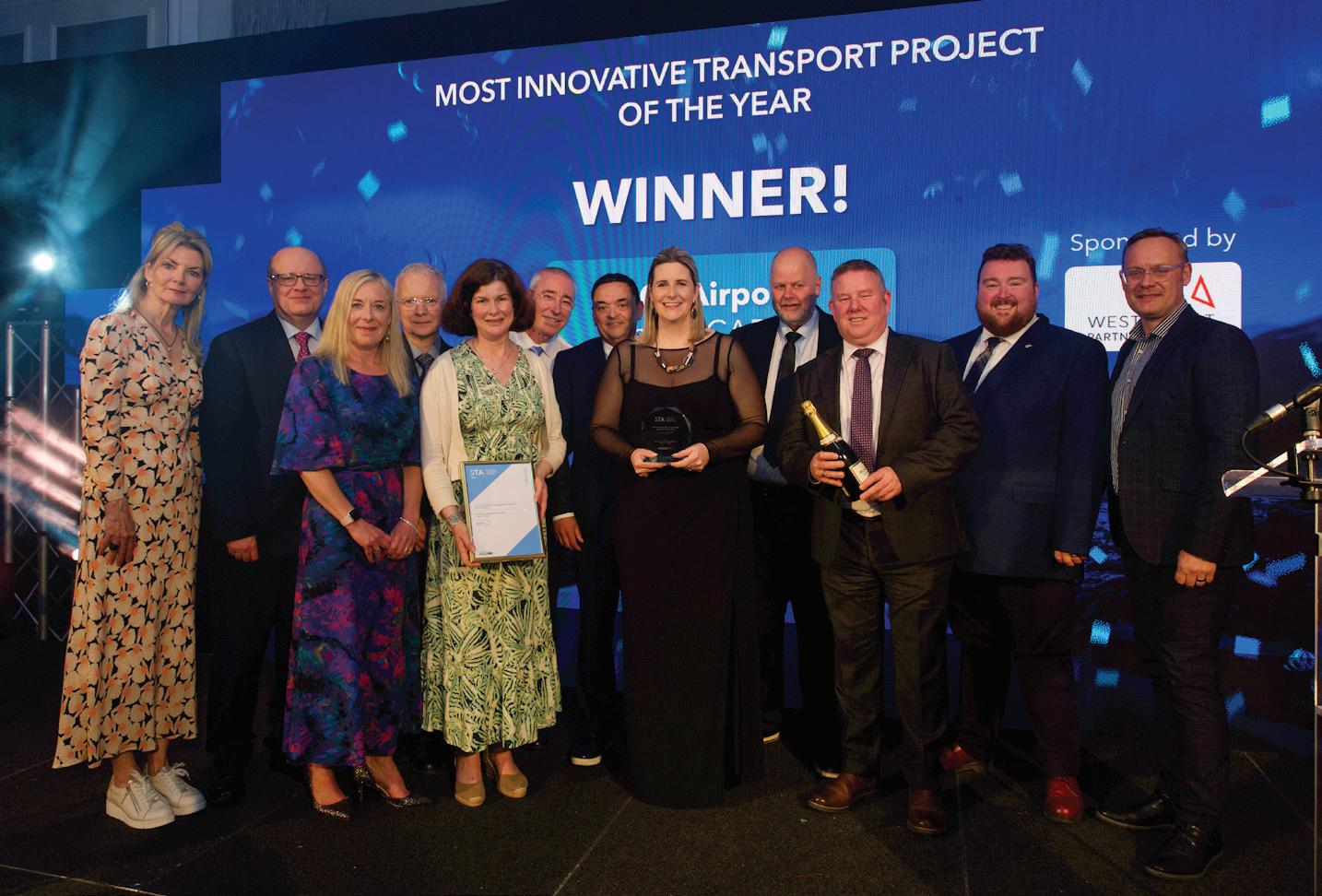
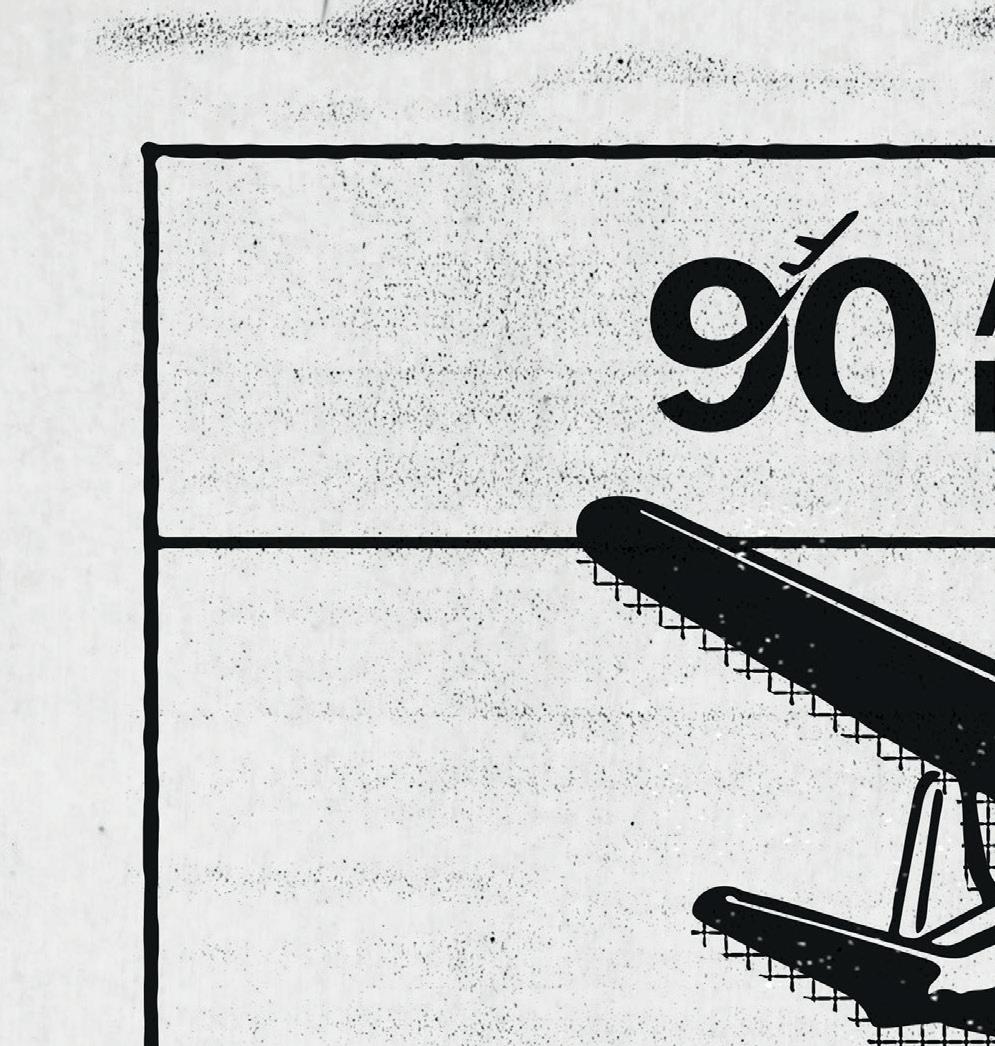


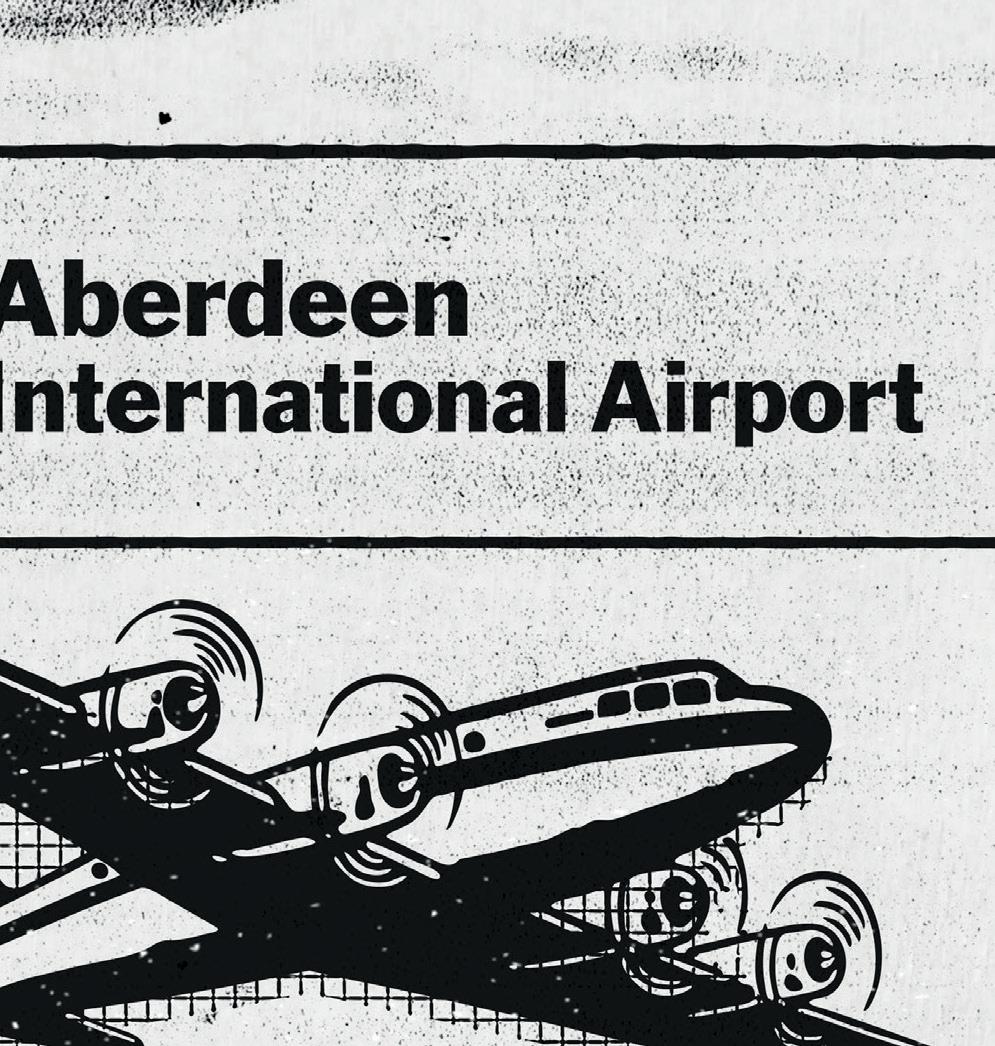





We went and launched our own #FreeToExplore streetwear range!
The colourful collection has come as our latest instalment in our Free to Explore campaign designed to encourage Scotland’s young people to explore their cities and surrounding areas using their free bus pass.
Working with Scotland’s finest, Glasgow artist Boiiing, accessories brand Trakke, and Glasgow School of Art, we created screenprinted t-shirts, hand-stitched bucket hats and sling bags inspired by our iconic seat designs. This design was such a hit that we took it on the road and wrapped some of our double-decker buses!



